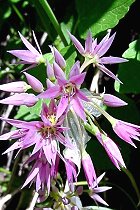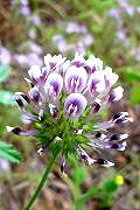-
Wahlenberg'ia/wahlenberg'ii: named for Georg (Göran) Wahlenberg of Uppsala (1780-1851), a Swedish naturalist and
 |
|
leading expert on Scandinavian mountain flora. He was born in Kroppa, Värmland County. Wahlenberg enrolled at Uppsala University in 1792 and received a doctorate in medicine in 1806. He was appointed as botanices demonstrator in 1814, and professor of medicine and botany in 1829, succeeding Carl Peter Thunberg. He was the last holder of the undivided chair that in the previous century had been held by Linnaeus. He studied homeopathy and introduced it into Sweden. Wahlenberg made his greatest con- tributions in the field of plant geography and published, among |
other things the Flora lapponica (1812) (not to be confused with the book of the same name published by Carl Linnaeus in 1737), Gotlands flora (1805-1806), Flora Carpathorum principalium (1814), Flora suecica (1824-1826; second edition, 1831-1834), and other works on the plant world and geography of northernmost Sweden. Swedish provincial floras in the full sense of the word begin with his. Flora Upsaliensis is considered a masterpiece of the genre. He was among the first major scholars to contribute to the plant taxonomy and geography of the High Tatra Mountains. He came to the Tatras, a range lying between Slovakia and Poland, on behalf of the Swedish Royal Academy of Sciences in order to systematically explore the rich flora of the central Carpathians and compare it with the flora of some of the Swedish mountains and the Austrian Alps. He worked in the High and Low Tatras and in the Great Fatra until 1813. The result of his work in the Tatras is the Flora Carpatorum Principalium (1814), which describes some 1,345 plant species. He was elected a member of the Royal Swedish Academy of Sciences in 1808. The genus Wahlenbergia in the Campanulaceae was published in 1821 by German physician and botanist Albrecht Wilhelm Roth based on a previous description by German botanist and mycologist Heinrich Adolph Schrader.
- wahl'ii: mamed for Herbert Alexander Wahl (1900-1975), a botanist and botany instructor at Pennsylvania State University specializing in the flora of Pennsylvania, particularly Carex and Chenopodium. Wahl served as curator of the herbarium until he retired in 1966. It was during his tenure that the herbarium added many new specimens primarily through the collections of his protégé Walter Westerfeld. He was married in 1925 and had one child.
-
wal'keri: named for the Reverend Elkanah Bartlett Walker (1805-1877), an American pioneer settler and missionary.
 |
|
He was born in North Yarmouth, Maine, and attended Bangor Theological Seminary. Walker wanted to serve in Africa under the American Board of Commissioners for Foreign Missions, but unrest there led the board to direct him towards the Oregon country. Following his ordination in 1838, Walker and his new bride, Mary Richardson, journeyed overland to the Oregon country in order to serve as missionaries for the Spokane Indians at Tshimakain Mission. The Walkers studied the Spokane language and prepared educational materials for publication by the Mission Press at |
Lapwai. After the Whitman Massacre (1847), they moved to Oregon and assisted in the organization of the Congregational Association in Oregon City. Walker and his wife had eight children in the Oregon country. The Tshimakain (“place of the springs”) Mission was founded by Walker, Cushing Eells and they and their wives lived there. On November 29, 1847, Cayuse Indians massacred the members of the Whitman Mission in Walla Walla. Elkanah Walker and Cushing Eells were supposed to be at the Whitman Mission during the time of the massacre, but Elkanah Walker became sick, and Cushing Eells did not want to leave the families without support during winter. The Oregon Mounted Volunteers escorted the Eells and Walker families to the area of Oregon City, Oregon on June 22, 1848. After arriving in Oregon City, Elkanah Walker purchased a wagon on credit and began freighting goods. He and his family moved to Forest Grove, Oregon in October 1849, where he purchased a donation land claim. He began farming and preaching. For many years he served Congregational churches in Forest Grove. Walker was a member of the first Board of Trustees of Whitman College in 1860. He gave land to the college on which the first building was erected. He died at Forest Grove. (Photo credit: Sasquatch Chronicles) ( Lilium canadense var. walkeri)
-
wal'keri: named for zoologist Ernest Pillsbury Walker (1891-1969). The
following is quoted from the website of the
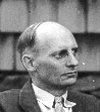 |
|
Washington
Biologists' Field Club: "Ernest was born in 1891 in Blue
Springs, Missouri, and grew up on farms in Indiana, Colorado, and
Utah. It was in this rural setting that his innate love for furred
and feathered wild things was nurtured throughout his childhood. His
formal education as a biologist was completed at the University of
Wyoming. After college Ernest went to Alaska as a warden and inspector
with the US Bureau of Fisheries and while there from 1913 to 1919,
he met and married the former Astrid Shafsted. On his return to the
lower 48 he served for two years as a |
US game warden in Arizona and California. In 1921, he went back to Alaska with the US Biological
Survey where he served as fur and game warden and as executive officer
and fiscal agent for the Alaska Game Commission. He came to Washington,
DC, in 1927 and assumed a position at the National Zoo under the director,
William Mann. He was assistant director of the National Zoological
Park from 1930 to 1956. Although his articles on animal life appeared
in such diverse publications as the National Geographic Magazine,
the Saturday Evening Post, and the Illustrated London News,
his life’s major publishing work was his three-volume Mammals of
the World. Other popular works included First Aid and Care
of Small Mammals and Studying Small Mammals. These two
books were published by the Animal Welfare Institute in which Ernest
served as an active member. Ernest was a charter member of the American
Society of Mammalogists. He was a member of the Masons and while in
Alaska was active with the Mount Juneau Lodge and its Eastern Star Chapter.
Ernest was considered a friend of the animals and worked diligently
throughout his life for their protection. He dedicated one of his
books “To the mammals, great and small, who contribute so much
to the welfare and happiness of man, another mammal, but receive so
little in return except blame, abuse and extermination.” Ernest
died on January 31, 1969, in a Rockville, Maryland, motel where he
was staying to be close to his doctor who was treating him for a chronic
heart condition. His wife had died in 1961 and his closest relative
at the time of his death was his sister with whom he had lived for
several years in Arlington, Virginia. Ernest was elected to membership
in the Washington Biologists’ Field Club in 1927 and received
an honorary membership in 1961." And from a 1948 Newsweek: "Since
he was a child on a fruit farm in Indiana, the zoologist has collected
every kind of animal, bug, and bird. He learned taxidermy in high
school, and put himself through the University of Wyoming doing biological
work. Thereafter he patrolled the salmon fisheries of Alaska for the
government and acted as a fur warden. But research was more to his
liking. In 1930 he was appointed assistant director of the Washington
zoo and he has been there ever since, blissfully surrounded by the
wild life that he finds not so very wild." The dust jacket of
his Mammals of the World says: "Upon discovering that there existed
no single book containing descriptions of all the world's mammalian
genera, Walker set out to collect information from every possible
source, searching tirelessly through thousands of books and articles
and corresponding with mammalogists the world over. His magnum opus
reflected an unequaled store of knowledge about the world's living
mammals." According to David Hollombe, Walker collected the type
specimen of this taxon at Paradox, Colorado in 1912, and it is for
this reason that his name is on it. ( Chylismia walkeri ssp. tortilis) (Photo credit: USGS)
-
walkeria'num: named for Harriet Ann Walker (1845-1929), an American botanist. The following is quoted from the book The Biographical Dictionary of Women in Science: L-Z by Marilyn Bailey Ogilvie and Joy Dorothy Harvey (2000): “Born in eastern New York to a Congregational minister, Harriet Walker was educated at Mt. Holyoke. There she received a bachelor’s degree (1870) while it was still a seminary; she was twenty-five. No record exists for what happened during the five years after her graduation, but she spent two years as the curator of the Wellesley College museum (1875-1877), and spent twelve years (1892-1903) as an assistant in the department of botany at Wellesley, and two years as the curator of the Wellesley College museum (1875-1877), while expanding her knowledge of botany. For thirteen years (1879-1892), she left university work and her botanical studies to work as a missionary in New York City. In the early 1890s, however, she spent two years studying at the New York State Library School. By 1905, then sixty years old, Walker moved to San Francisco, where she worked on the Berkeley campus of the University of California as an assistant in the herbarium; she stayed until she retired at the age of eighty-three. During this time she made collections of the native plants for the herbarium and distributed duplicates to other institutions. Most of her excursions were in the San Francisco Bay region, but she sometimes went further afield to the Mendocino Range and to the Sierra Nevadas. She died two years after she retired, leaving property valued at about four thousand dollars to the University of California."
-
wallac'ei: named for Alexander Wallace (1829-1899), an English physician, botanist, and entomologist born the son of a barrister in London. He was awarded an MA from Trinity College, Oxford, in 1858 and an MD in 1861. He also received professional training at St. Bartholomew’s Hospital. In 1857 he was elected to the Royal College of Physicians. He began his medical practice in London and was physician to the Middlesex Free Hospital and the St. Pancras and Northern Dispensary. Later he moved to Colchester and while resuming his medical practice there also started growing bulbs, especially Japanese lilies. He worked as an agent for introducing new species of lilies and orchids, and established a company named The New Plant and Bulb Company. He supplied lilies to the British horticulturist, garden designer, craftswoman, photographer, writer and artist Gertrude Jekyll who created over 400 gardens in the United Kingdom, Europe and the United States, and wrote over 1,000 articles for magazines such as Country Life and William Robinson's The Garden. Alexander Wallace published the first edition of Notes on lilies and their culture in 1873 and a second edition in 1879. He was known as an ardent lepidopterist and became a regular attendant and member of the Entomological Society of London. For two of his essays he won prizes from the Entomological Society of London in 1865–1866 and was a member of several learned societies. His sons had a very large and prosperous business of the same nature at Colchester. He died at the age of 70 in Colchester. (Calochortus benthamii var. wallacei)
-
wallac'ei: named for William Allen Wallace (1815-1893), who collected in the vicinity of Los Angeles around 1854.
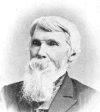 |
|
He was born in Pembroke, New Hampshire, and moved with his family to Canaan, New Hampshire in 1817 when he was 2. He was educated in schools there and although apparently prepared to enter Dartmouth College, I have no evidence that he actually did. In 1831 a local paper, the New Hampshire Post, which was printed at Haverhill, New Hampshire, was advertising for a boy, and he very much wanted to learn to set type and so was allowed to become an apprentice. His father died later that same year and he remained in Haverhill for two years. Then the office was sold and re- |
moved to Concord, and he went with it and stayed an additional year, at which time he left. In 1834 he went to work for Alfred Beard of the Nashua Telegraph, which position he held for two years. His next few years were a peripatetic mix of school and various printing jobs in Charlestown, MA, East Bridgewater, MA, Boston, and Worcester, MA. He was attracted by the sea and almost joined the Navy. By 1849 the idea of moving west had taken strong hold of him, and it was in 1850 that he finally pulled up stakes and moved to California. [He] "worked as a gold miner, schoolteacher [in San Gabriel], and newspaper editor. Although the dates aren’t clear, he apparently traveled back and forth many times between his home in New Hampshire and Los Angeles, but whether this was before or after he moved back east to Canaan, NH, I don't know. In 1856 he became an honorary member of the California Academy of Sciences for his work as a field botanist. He was editor and proprietor of the Los Angeles Star during 1853-1856, and in 1857 became a correspondent for San Francisco's Daily Alta California, reporting on travels in the West and from Washington, DC, during the Civil War. Wallace settled in Canaan in 1865, where he conducted research for a town history, published posthumously in 1910." (Quoted from the online Yale Digital Content webpages). He had tried farming in the Napa Valley when he first moved to California. While in Los Angeles he became a plant collector, but at some point he returned to the east. According to Islapedia, he collected plants on Santa Catalina island in 1859 including what came to be called Solanum xanti var. wallacei. Back in New England, Wallace paid Asa Gray a visit at Harvard College, giving the plant specimens to him. Gray instructed him how to properly collect and prepare plant specimens for submission. There seems to be little information available about what he was doing during the 28 years after he moved back to New Hampshire in 1865, but he was the co-author with his brother James Burns Wallace of The History of Canaan, New Hampshire which was published posthumously. (Photo credit: Find-a-Grave) ( Eriophyllum wallacei, Nicotiana bigelovii var. wallacei, Solanum wallacei, and possibly Selaginella wallacei)
-
wallia'nus: named for Lloyd Arthur Wall (1895-1971), assistant range supervisor, US Forest Service, born at Buena Vista, Colorado, and died at Silver City, New Mexico. The one taxon in California was the former Lupinus argenteus var. wallianus.
-
wallich'ii: named for the Danish botanist and surgeon Dr. Nathaniel
Wallich (1786-1854). The following is quoted
 |
|
from the PlantExplorers.com
website: "Nathaniel Wallich was born at Copenhagen in Denmark
on January 28, 1786. In 1806 Wallich obtained the diploma of the Royal
Academy of Surgeons at Copenhagen and in the autumn of that year was
appointed surgeon to the Danish settlement at Serampore, then known
as Frederischnagor in Bengal. He sailed for India in April 1807 and
arrived at Serampore the following November after a long sea voyage
around the African Cape. The Danish alliance with Napoleon turned
disastrous and resulted in many Danish colonies being seized by the |
British, including the outpost at Serampore. Wallich was held as a
prisoner of war but later, in 1809, he was released from his parole
on the merit of his scholarship. On his release Wallich was appointed
assistant to William Roxburgh, the East India Company's botanist in
Calcutta. Although ill health forced Wallich to spend the years 1811-1813
in the relatively more temperate climate of Mauritius, he still pursued
his studies. Wallich's keen interest in the native flora
and fauna of India, and his scholarly work with collecting and cataloguing,
was making impressions both locally and abroad. As a member of the
Asiatic Society, Wallich was the driving influence behind the Society's
foundation of the Oriental Museum of the Asiatic Society in February,
1814. Offering both his services and a number of items from his own
collections, Wallich founded the museum and took charge as the honorary
curator and then superintendent. However, Wallich continued to work
in the medical profession and by August, 1814 he was working as assistant
surgeon for the East India Company and consequently he had to resign
as superintendent of the museum in December, 1814. The museum, later
known as the Indian Museum in Calcutta, thrived under the guidance
of its enthusiastic founder and the many collectors he supported and
inspired. Most of them were Europeans except a solitary Indian, Babu
Ramkamal Sen, initially a collector and later the first Indian secretary
to the Asiatic Society. Wallich had been involved with the East India
Company's Botanical Garden at Calcutta almost from the day he arrived,
but took on a permanent position as superintendent of the garden in
1817. Although he continued his duties at the museum, by 1819 he devoted
himself entirely to the garden. As a well respected botanist Nathaniel
Wallich prepared a catalogue of more than 20,000 specimens, published
two important books, Tentamen Flora Nepalensis Illustratae (1824-26)
and Plantae Asiaticae Rariories (1830-32), and went on a number of
expeditions himself. However, one of Wallich's greatest contributions
to field of plant exploration was the assistance he regularly offered
to the many plant hunters who stopped in Calcutta on their way to
the Himalayas. Wallich was responsible for packing many of the specimens
that came through the gardens on the way to England, and over the
years he developed some innovative methods, including packing seeds
in brown sugar. Strange as it may seem, the sugar preserved and protected
the seeds very well and, in fact, Wallich had one of the best records
for keeping plant material alive for shipping prior to the development
of the Wardian Case. Wallich retired to London in 1847 and died
there on April 28, 1854. On the occasion of his bicentenary, in 1986,
the Indian Museum instituted an annual lecture series in memory of
the founder of the museum movement in India.
-
walpolia'na: named for Frederick Andrews Walpole (1861-1904), a botanical artist born in Port Douglass, New York,
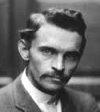 |
|
and considered the best plant artist in the United States. In 1871 he moved with his parents to Chicago, Illinois, where he became a pupil of an artist named Sloan, possibly Junius R. Sloan (1827–1900), a landscape and portrait artist then working in that city. In 1882 he set out by rail and foot for southern Oregon where he sought to gain a homestead. He arrived first in Redding, California, in the Sacramento Valley, proceeded by foot 177 miles to Jacksonville, where he explored the area, eventually taking up a land claim in the Crater Lake area. At some point his |
family came out to Portland and in 1886 Frederick took a job as illustrator for The Lewis and Dryden Printing Company, a lithographic establishment. In 1893 he married an English girl, Edith Ruth Budgett, in England. In 1896 the Department of Agriculture, particularly Frederick Coville, a USDA botanist and curator of the National Herbarium who was in Oregon researching plants used by the Klamath Indians, became aware of his drawings of plants and he was offered a position as artist for the Division of Botany of the USDA which he accepted. His method was generally to make his drawings from living plants growing under their natural wild conditions. His summers were spent mainly in the field, and his winters at the National Herbarium in Washington, where he completed and perfected his work. His later journals show him on field drawing trips botanizing, collecting specimens and confidently identifying plants by their scientific Latin names. After 1902 he also worked at the National Museum. He held frequent exhibitions at Washington's Corcoran Gallery and at the Library of Congress. A website of the Hunt Institute for Botanical Documentation finishes up by saying: “As a botanical artist, Walpole worked in watercolor, ink, and pencil. Coville described Walpole's unusual technique of ink drawing. Using the finest sable brush from which all but a few of the bristles had been cut away and holding it almost parallel to the surface of the paper, Walpole drew lines of extraordinary delicacy. Avoiding any degree of contrived artificiality, Walpole produced honest portraits of plants that, to a remarkable degree, succeed in capturing on paper the fragile grace and living essence of the plants themselves. Frederick Walpole died, from typhoid fever contracted while working in California, 11 May 1904. While his short career had gained him no wide recognition, the character and sincerity of the man himself had earned the respect and esteem of his friends and colleagues. We may regret that Frederick Walpole's career was cut so short, that his plant illustrations were never widely reproduced and published (as they doubtless would have been had he worked at an earlier period), and that he painted so few pictures for gallery exhibition, but we can be grateful for a few hundred plant illustrations of a very high order, which the Hunt Institute is proud to represent in this exhibition and in our Art collection.” Walpole’s wife died in 1898 when their son was only three, and he later died of typhoid fever in Santa Barbara. (Photo credit: Hunt Institute for Botanical Documentation)
-
wal'teri: named for Walter Fry (1859-1941), a forest adminstrator born in Illinois. He came to California with his
 |
|
family in 1887 due to hard times in the American midwest, and worked first as a farmer, then for a lumber company, but developed an antipaty to cutting down the Big Trees. He entered government service in 1901 and worked his way up to superintendent of Sequoiah and General Grant National Parks (which is what the area called the General Grant Grove is now called). When the Army gave up caretaking the parks in 1914, the choice for civilian superintendent was a clear one. Fry became superintendent of Sequoia and General Grant National Parks, a position he would hold for the next |
six years. Ranger work in the early 20th century had a very different character than in more recent times, and Fry’s primary duty was to keep an eye on all corners of the two parks. He later calculated that during the early years of his government employment, he rode over 50,000 miles on horseback on mountain trails. During that time, he observed the natural world carefully and kept extensive notes about the parks’ flora and fauna. Ranger work in the early 20th Century had a very different character than in more recent times, and Fry’s primary duty was to keep an eye on all corners of the two parks. He later calculated that during the early years of his government employment, he rode over 50,000 miles on horseback on mountain trails. During that time, he observed the natural world carefully and kept extensive notes about the parks’ flora and fauna. He then became commissioner for those two parks from 1920 until his death. When the Army gave up their caretaking responsibility for the parks in 1914, the choice for a civilian superintendent was a clear one. Fry became superintendent of Sequoia and General Grant National Parks, a position he would hold for the next six years. In 1930 he and Sequoia National Park superintendent John White published the book Big Trees reflecting his careful observation of nature. Even after he retired in 1930, at age 71, Fry offered walks, wrote nature bulletins and organized visitor centers; the thousands of visitors he touched in turn became ambassadors for the landscape he loved so much. In the 1930s the park published a volume of his “nature notes” that captured important stories of the park’s earliest days. (Much information taken from a website of the National Park Service and photo credit to the same).
-
ward'ii: named for Lester Frank Ward (1841-1913), an American botanist, paleontologist, and sociologist, first presi-
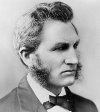 |
|
dent of the American Sociological Association. He was born in Joliet, Illinois. His father Justus was a farmer and his mother was the daughter of a clergyman. He moved at the age of one to the Chicago area, then the family moved to a homestead in nearby St. Charles, Illinois, where his father built a saw mill business making railroad ties. He received no formal schooling until he was nine when he displayed a great enthusiasm for books and learning. Four years later his family moved again in a covered wagon to Iowa for a new life on the frontier, but Justus died unexpectedly in |
1858, and Lester, or Frank as he preferred to be called, and his brother Erastus, moved back to the St. Charles homestead. The two brothers farmed to make a living and sought to acquire education, and in 1858 they moved to Pennsylvania where their older brother Cyrenus was starting a business making wagon wheel hubs. They saw this as an opportunity to move closer to civilization and to eventually attend college. After the business failed Lester began teaching at a small country school and doing farm labor until in 1860 he had saved enough money to enroll at the Susquehanna Collegiate Institute. Two years later he was married to Elizabeth Carolyn Vought (some sources say Bought), and subsequently joined the Union Army, being wounded three times. After the war he became employed by the federal government’s Treasury Department until 1881 in Washington, DC. His wife helped him edit a free-thinking newsletter called " The Iconoclast." While in Washington he enrolled at Columbian College (now George Washington University) and graduated in 1869 with an AB degree, and in 1871 he received the degree of LLB. He was admitted to the bar of the Supreme Court of the District of Columbia, and was awarded an AM degree in 1873. Lizzie died in 1872 and he was remarried the following year to Rosamond Asenath Simons. For the government he was carrying out basic research in such fields as geography, paleontology, archeology and anthropology, and in 1883 he became geologist of the US Geological Survey. He became friends with its director John Wesley Powell, also director of the Bureau of Ethnology at the Smithsonian. In 1892, he was named paleontologist for the USGS, a position he held until 1906, when he resigned to accept the chair of sociology at Brown University. Ward is best remembered for his pioneering work in sociology. Between 1883 and his death in 1913, he completed several important works including Dynamic Sociology (1883), Outlines of Sociology (1898), Pure Sociology (1903), and Applied Sociology (1906). Ward's most important contribution to sociology was his insistence that social laws, once identified, can be harnessed and controlled. Ward supported the idea of equality of women as well as the equality of all classes and races in society. He believed in universal education as a means of achieving this equality. Many of his ideas were unpopular among his male contemporaries, but would probably play better to an audience today. He attacked the laissez-faire principles of Herbert Spencer and was a strong supporter of the welfare state and equality for women. He helped to shape early environmental policies, was opposed to slavery, and although his views on race were arguably more progressive and in tune with modern standards than any other white academic of his time, some of his beliefs and attitudes would be considered racist today. He kept voluminous diaries for many years, but after his death in Washington, DC, his wife destroyed all but his first diaries.
-
war'ei: named for Thomas Softley Ware (1825-1901), an English florist who ran the Hale Farm Nurseries, Tottenham, London, specializing in peonies, carnations, and other bulbs and perennials. He was the author of Hardy Perennials published in 1893.
-
warneren'se: of or from the Warner Mountains in eastern Modoc County.
- Warnstorf'ia/warnstorf'ii: named for Carl Friedrich Warnstorf (1837-1921), a German educator, florist, botanist and
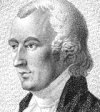 |
|
bryologist specializing in sphagnum studies. He was born in Lubuskie, Poland. Wikipedia provides these few brief details: “He received his education at the teaching seminar in Neuzelle from 1855 to 1858, afterwards working as a school teacher in Arnswalde from 1859 to 1867 and Neuruppin from 1867 to 1899. Following retirement from teaching he settled in Berlin. In 1917 he was awarded with the title of professor. During World War II his herbarium of 30,000 items was destroyed in the midst of the bombing of Berlin in 1943.” He was the author of Die Europäischen |
Torfmoose (1881) (European Sphagnum), Zur Bryo-Geographie des Russischen Reiches (1913-14) (Bryo-geography of the Russian Reich).and other works. He died in Berlin. The genus Warnstorfia was published by Leopold Loeske in 1907.
-
Washington'ia: named for George Washington
(1732-1799), 1st president of the United States. He was born in colonial
 |
|
Virginia and after some early schooling he became a surveyor. He joined the Virginia militia and fought in the French and Indian War. He was made Commander-in-chief of the Continental Army in 1775 by the 2nd Continental Congress. He was unanimously chosen to lead the Constitutional Convention in 1787 which devised the new federal government. Washington was unanimously elected as president by the electoral college in the first two national elections. He inherited slaves and owned slaves throughout his life, but freed them in his will. He was a prolific land buyer and |
accumulated some 70,000 acres of land during his lifetime. His early life as a surveyor and a military officer took him into wild lands and exposed him to nature in a way that few others in colonial times experienced. He died at his home at the age of 67. The genus Washingtonia was published by German botanist Hermann Wendland in 1879, but the qustion I have long wondered about is why it was named for G.W.? Most sources don't address this issue, but apparently when Wendland saw the palms he only knew that they came from the United States, so he decided to name them for Washington. I don't know if this is apocryphal or not, but an interesting article in the website The Daily Gardener relates the following story. “The mystery of the California fan palm was not about how it got its name but rather where it came from - California or Arizona. In 1976, researchers made a discovery that helped solve the 100-year-old mystery. Here's the fascinating backstory: In 1879, a German botanist, Herman von Wendland, saw the palms growing in a Belgium nursery. He named the palm Washingtonia filifera in honor of George Washington. The name seemed appropriate since Wendland only knew that the seeds for the palms had been collected in America. Wendland had no idea which state was home to the palms. Three years earlier, in 1876, the German botanist Georg Drude had noted that the seed was collected in Arizona, along the Colorado River. An Italian botanist, Dr. Francesco Franceschi, also said that the palms were from Arizona. But a Stanford botanist named Samuel Parish disagreed. Parish knew that the area where the seeds were supposedly collected was near Prescott. According to Parish, this was "a region of pines rather than of palms." To Parish, the seeds had to come from California. But what Parish didn't realize is that there were small groves of Arizona palms roughly 38 miles from Prescott - near Castle Creek, CA. Next, the researchers wondered how the Arizona palm seeds ended up in Belgium? Well, it turns out, the 1870s stagecoach line went right along Castle Creek to Prescott, Arizona, and then onto Santa Fe, New Mexico. In September, 1872, the Czech botanist and extreme orchid hunter Benedict Roezl was in that part of the southwest on his way to Mexico. Roezl likely bought some of the ripe purple fruit from those Castle Creek Arizona palms and then sent the fruit back to Germany with his other specimens. And that is how the Arizona fan palm was named the California fan palm by a German botanist who saw them growing in Belgium.”
- washingtonia'na: probably after either the state of Washington or
Lake Washington near Seattle, where the type specimen of Claytonia washingtoniana was found.
-
washingtonia'num: named for Martha Dandridge Custis Washington (1731-1802), wife of the first US president. She
 |
|
was born on her parents' plantation Chestnut Grove in the British colony, Province of Virginia. She had three brothers and four sisters and apparently had a half-sister who was born into slavery. She also may have had an out-of-wedlock half-brother who was white. At the age of 18 she married a rich planter named Daniel Parke Custis, and two years after he died in 1757 she married George Washington. During the Revolutionary War she joined him for all the Continental Army's winter encampments. She was not in favor of him accepting the presidency and she did not attend his |
inauguration. As a result of her first marriage, she had inherited great wealth which George used frequently to buy land and slaves. She was primarily a manager of the household and does not seem to have had much in the way of other non-social activities. She died two and a half years after the death of her husband. Lilium washingtonianum is often called the Washington lily but it does not occur naturally in that state. Albert Kellogg named the species for the first First Lady for reasons that I have been unable to determine except that she was the chief overseer of the Mt. Vernon plantation and a gardener herself. But as with the generic name of Washingtonia, it seems that few people are curious about either of these etymologies.
- washoen'sis: of or from Washoe County, Nevada.
-
watkins'ii: named for William Grant Watkins (1870-1944), an apiarist, carpenter, botanist and plant collector born in Erie, PA. He moved from Virginia City, Nevada, to the present outskirts of Placerville in 1880, first earned his livelihood as a carpenter, but his deep interest in wild flowers and bees persisted from an early age. He propagated and distributed widely native bulbs and plants while continuing his study of botany and bee culture, becoming a leading bee-keeper and in time an authority on honey, bees and their diseases, and the flowers on which they fed. He was long an active and highly respected member of the Bee-keepers Association, and exhibited many kinds of honey and won many prizes at state and county fairs. He later became a field botanist at the Davis field station of the US Department of Agriculture, where one of his major accomplishments was the breeding of bees immune to poisonous plants. He was also the rediscoverer of the rare Arctostaphylos nissenana. He died at Placerville, California.
-
Watson'ia: named for Sir William Watson (1715-1787), an English botanist and physician, apothecary, physicist,
 |
|
fellow of the Royal Society, and writer on subjects like electricity and lightning. He was born the son of a tradesman in London. He entered the Merchant Taylor’s School in 1726 and was apprenticed to an apothecary in 1730. He had a strong interest in botany and made many trips into the countryside in seach of plants. He married in 1738 and set himself up in business. He helped to introduce the work of Carl Linnaeus into England. He became a fellow of the Royal Society in 1741 and vice-president in 1772. In 1757 he was created a doctor of physic at the University of Halle. In |
1781 he was elected a fellow of the Royal College of Physicians. About his electrical experiments, Wikipedia says that “In 1746, he showed that the capacity of the Leiden jar could be increased by coating it inside and out with lead foil. In the same year he proposed that the two types of electricity—vitreous and resinous—posited by Charles Francois de Cisternay du Fay were actually a surplus (a positive charge) and a deficiency (a negative charge) of a single fluid which he called electrical ether, and that the quantity of electrical charge was conserved. He acknowledged that the same theory had been independently developed at the same time by Benjamin Franklin—the two men later became allies in both scientific and political matters. On 14 August 1747 he made an experiment to conduct electricity through a 6,732-foot long wire at Shooter's Hill in London. At another experiment he made, the wire was 12,276 feet long. Previous experiments in France had only tried shorter distances.” He died in London. The genus Watsonia was published in 1758 by Philip Miller.
-
watsonia'na/watsonia'num/watsonia'nus/watson'ii: named for Sereno Watson (1826-1892)
of Harvard, assistant to Asa
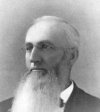 |
|
Gray and curator of the Gray Herbarium at Harvard University, a distinguished American botanist who named
and described many new species found during the pioneer botanical
explorations of western and middle North America. Born on a farm in
Connecticut, he graduated from Yale in 1847 and some years taught
school, did editorial work and studied medicine, after which he went
back to Yale to study chemistry and mineralogy. He decided to move
to California and participated in Clarence King's geological survey
of the 40th parallel, becoming the expedition's botanist by |
replacing
William Whitman Bailey who left on account of poor health. He wrote
and published Botany of the King Expedition in 1871, working
first at New Haven with Daniel Cady Eaton and then at Harvard under
Asa Gray. His report was considered the most useful of the several
survey expedition reports and he was appointed an assistant at the
Gray Herbarium in 1873, then curator, which position he held until
his death. While at Harvard, he also worked with William H. Brewer
and Gray on the first volume of Botany of California,
publishing by himself the second volume in 1880. He also completed
the Manual of the Mosses of North America, published in 1884,
which had been begun by Thomas Potts James and Leo Lesquereux. He botanized
in the northwestern United States in 1880, in Guatemala in 1885, and
traveled to Europe in 1886. He was not considered an innovator in
the botanical field, but was respected primarily because of his meticulous
nature and careful notetaking in the field.
-
web'beri: named for David Gould Webber (1809-1883), "...son of William
and Susanna Webber, born in
Livingston County, New York, September 12, 1809. When sixteen years
old he began working on a canal in summer, attending school in winter,
and followed this for two years, when he engaged as a drug clerk and
student with Dr. Woodworth of Springfield, Pennsylvania. Three years
after, young Webber bought him out, and continued in business for
twelve years. In 1843 he closed out his business there, and dealt
in stock for two years. He went to Chicago in 1845, and bought a half-interest
in a steam flouring mill, and was also a contractor on the Illinois
canal for about four years. He
started for California in December, 1849, via Panama, and upon his
arrival in April, 1850, went to Downieville, and mined during the
summer of 1850. In 1851 he located the Oak Ranch near Monte Christo,
but sold out the next year and bought a sawmill in Downieville, going
also into stock-raising in Scott Valley. During the four years following,
Dr. Webber superintended the building of the first wagon road to Downieville,
the first bridge across the Yuba river, and the courthouse, jail, and
jailer's house. He was school superintendent of Sierra County two
years. During this time, in 1852, he
located all the land around what was then called Little Truckee Lake
(now known as Webber Lake), for a stock range, and in 1854 stocked
the lake with trout, there having been previously no fish in it, because
of the falls a mile below. In 1860 he built the Webber Lake hotel
there, and opened it to
the public that year. The ranch he lived on, four miles north of Loyalton,
was located by him in 1859, where he spent the winters, and he ran
the hotel at the lake during the remainder of the year, until 1877.
He practiced medicine in Loyalton for three years. In 1833 he was
married to Miss Margaret Bradish of Cranerville, Pennsylvania, by
whom he had one child, James W., who was born in 1835, and died in
Sacramento in 1856. Mrs. Webber died in 1842." (from Plumas
County Biographies) He accompanied and collected plants for John
G. Lemmon, one of which (Ivesia webberi) he found on his own
ranch and which Lemmon named in his honor.
-
Web'era: named for Georg Heinrich Weber (1752-1828), a German physician, university teacher, botanist and plant collector born in Gottingen. He was a professor at the University of Kiel known for his work on lichens, algae, and bryophytes in addition to seed plants. His son was the entomologist Friedrich Weber. He was the author of several works. He died at Kiel. He was the author of Primitiae Florae Holsaticae (1780) and Spicilegium florae Goettingensis (1778). The genus Webera was published by Johann Christian Daniel von Schreber in 1791.
-
Weberas'ter/web'eri: named for William Alfred Weber (1918-2020), an American botanist and lichenologist. A web-
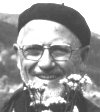 |
|
site of the Australian National Herbarium provides the following: “Weber grew up in New York City and became interested in botany at the age of 4, when he received the gift of a small microscope. Depression-era New York City provided an ideal setting for a young naturalist who frequented the city’s parks and natural history museums, joined walking clubs and even founded his own bird club. He continued his education formally with a BS degree in botany from Iowa State University (1940) and MA (1942) and PhD (1946) degrees in botany from Washington State |
University. He began his career at the University of Colorado at Boulder in 1946 as a biology instructor. In 1962, he became a professor of natural history. In 1951, he entered the world of lichenology, which he calls the ‘most significant event in my life.’ This continuing passion resulted in the 1998 publication of A Rocky Mountain Lichen Primer with former CU-Boulder Chancellor James Corbridge. In 1957-1958, Weber received a National Science Foundation Senior Post-Doctoral Fellowship to spend a year at the Riksmuseum in Stockholm conducting research in Sweden, Norway and Denmark. In 1964, he participated in an international expedition to the Galapagos Islands and, over a period of nine years, collected and published the first studies of their lichens and bryophytes. Subsequently, he did intensive work in Australia, New Guinea, Siberia, Scandinavia, the American Arctic and Nepal. His study of historical plant geography in these regions has led to his own hypotheses about plant origins and distribution. In 1962, Weber also became the curator of the fledgling herbarium collection of plant specimens at the CU Museum of Natural History. That collection now holds more than half a million specimens and was named The W.A. Weber Collection in 2012. William Alfred Weber was, in 2015, professor emeritus at the University of Colorado at Boulder, and former curator of the University of Colorado Museum Herbarium (Index Herbariorum designation COLO).” In 2018 he won the Acharius Medal of the International Association for Lichenology, and the Elizabeth Britton Award for Lifetime Achievement in Bryology, and the Chicita Culberson Award for Lifetime Achievement in Lichenology of the American Bryological and Lichenological Society. In 1984 he was elected a member of the Linnean Society of London. He is co-editor, with Ron Wittman, of the Colorado Flora Series, which has been in continuous publication since 1953, with the most recent publication in 2012 in two volumes: Colorado Flora: Eastern Slope and Colorado Flora: Western Slope. This work remains the most authoritative contemporary reference to the flora of Colorado, and each volume fits easily into a backpack for research in the field. In addition to the places he visited listed above, he also traveled to the Canadian Rockies, Mexico, Russia, Japan, the Canary Islands, Greece and Turkey, Peru and Chile, Crete, the French Alps and Switzerland. The genus Weberaster was published by Áskell Löve and Doris Benta Maria Löve in 1982.
-
Wedel'ia: named for Johann Wolfgang Wedel (1708-1757), German botanist, author and professor of medicine at Jena. He was the son of Johann Adolph Wedel (1675-1747), a professor of medicine at the University of Jena, and the grandson of Georg Wolfgang Wedel (1645-1721), professor of surgery, botany, theoretical and practical medicine, and chemistry. He was the author of Tentamen botanicum: flores plantarum, and was Court Councilor of the Holy Roman Empre. He was born and died at Jena. The genus Wedelia in the Asteraceae was named for him and published by Nicolaus Joseph von Jacquin in 1760.
-
weed'ii: named for Amos Weed (1828-1918). Born
in Amesbury, Massachusetts, he became a carriage maker by trade
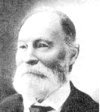 |
|
and with his schoolteacher cousin Ephraim Weed, Morse joined the New England
Trading and Mining Association. Desirous of traveling to the
gold fields of California, each member contributed $300 to buy a ship
named the Lenore and cargo in Boston, and the group sailed
around Cape Horn to San Francisco, arriving in 1849. After the
ship and its cargo were sold, most of the members headed for the gold
country, where Weed and Morse tried placer mining. Many of them
were affected by the scurvy and typhoid fever that was prevalent around
the gold camps, and both |
men decided to resettle to San Diego, Morse becoming a prosperous and respected citizen of that community, and
Weed taking up carpentry. After a brief period Weed returned
to San Francisco and took up gold mining again, spending several years
in Tuolomne County, and living for a while in the Hawaiian Islands.
In the Tuolomne area he picked up an 18-1/2 oz. gold nugget.
He finally settled in San Diego in 1862, and resumed his close
relationship with his cousin Ephraim. He apparently worked as
a farmer and a carpenter, and collected plants on the side, one of
which was the beautiful mariposa lily named for him by Professor
Alphonso Wood. Ephraim became a merchant, lawyer, real estate
promoter and civic official, and one of the interests in which he
had a part ownership was the Oriflamme Mine and Mill which was situated
four miles east of Cuyamaca. In the early 1870s there was a
minor gold rush in the Julian-Banner area of the mountains east of
San Diego, and Weed again took up his gold pan to seek a fortune,
but soon taking over management of the Oriflamme Mine and Mill where
he worked until 1876. I don't know anything about the period
of his life that followed this. He never married and died April
29, 1918, and in accordance with his wishes, his ashes were scattered
along the tracks of the San Diego and Arizona Railway, in which he
had had a longtime interest. (Photo credit: San Diego Historical Society Quarterly October 1957)
- weigel'ii: named for Christian Ehrenfried von Weigel (1748-1813), a German scientist. He was born in Stralsund,
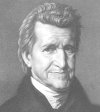 |
|
studied under Johann Christian Polycarp Erxleben in Göttingen, and received a degree in 1771 from the University of Göttingen. In 1806 he was ennobled and added a ‘von’ to his name, and in 1808 he became the personal physician of the Swedish royal house. Among other things, Weigel developed a cooling heat exchanger in 1771, which was later improved upon by Justus von Liebig and then became to be known as the Liebig condenser. Beginning in 1774, he was a professor of chemistry, pharmacy, botany, and mineralogy at the University of Greifswald. At his own expense, |
he set up a chemical laboratory (in the former "Black Monastery," on the site of today's medical clinics in Friedrich-Loeffler-Strasse) and occasionally held chemical exercises for physicians there. In 1792, he was elected a foreign member of the Royal Swedish Academy of Sciences. He was honored with the genus name Weigela published by Carl Peter Thunberg in 1780.
-
weinmann'ii: named for Johannes Anton Weinmann (1782-1858), a German-born Russian botanist and mycologist. In 1803, along with Gottfried Albrecht Germann, the first professor of natural history (botany) at the University of Tartu, Weinmann established the botanical garden there. He was a learned gardener and went on in 1823 to serve as Inspector of Gardens for Empress Maria Fyodorovna in Pavlovsk near St. Petersburg. He also studied fungi and his name is commemorated with the mycological genera Weinmannioscyphus and Weinmannodora. He published a flora that is the basis of some binomial species identifications. Because of these two men the species richness of the botanical garden of Tartu grew rapidly. By 1808 the garden contained some 4,568 species, by 1827 10,499, and by 1845 about 14,000 species.
-
Weis'sia: named for Friedrich Wilhelm Weiss (1744-1826), a German physician, botanist, mycologist and lichenologist of Göttingen. The genus Weissia was published by Johann Hedwig in 1801.
-
Wellington'ia/wellington'ia: named for Arthur Wellesley, 1st Duke of Wellington (1769-1852), Anglo-Irish soldier and
 |
|
Tory statesman who was one of the leading military and political figures of 19th-century Britain, serving twice as prime minister. He won a notable victory against Napoleon at the Battle of Waterloo in 1815. Wellesley was born in Dublin into the Protestant Ascendancy in Ireland. He was commissioned as an Ensign in the British Army in 1787, serving in Ireland as aide-de-camp to two successive Lords Lieutenant of Ireland. He was also elected as a member of parliament in the Irish House of Commons. He was a Colonel by 1796 and saw action in the Netherlands and in India, |
where he fought in the Fourth Anglo-Mysore War at the Battle of Seringapatam. He was appointed governor of Seringapatam and Mysore in 1799 and, as a newly appointed Major-general, won a decisive victory over the Maratha Confederacy at the Battle of Assaye in 1803. He studied at Eton College from 1781 to 1784. In 1785 he and his mother moved to Brussels, and the following year he enrolled in the French Royal Academy of Equitation in Angers where he learned horsemanship and French. He had a long and storied military career, one comparable to few others in British history, and one that has been recounted elsewhere and would take pages to describe. Wellington entered politics again when he was appointed Master-General of the Ordnance in the Tory government of Lord Liverpool on 26 December 1818. He also became Governor of Plymouth on 9 October 1819. He was appointed Commander-in-Chief of the British Army on 22 January 1827 and Constable of the Tower of London on 5 February 1827. One of the major accomplishments of his period was the granting of almost full civil rights to Catholics in Great Britain and Ireland in what was called the Catholic Emancipation. As an Irishman, he understood what the grievances of Catholics were. He became prime minister in 1828 but lost an election and fell from power in 1830. He remained active in politics, was foreign secretary in the first cabinet of Robert Peel, leader of the House of Lords, and was also re-appointed Commander-in-Chief of the British Army. He became chief ranger and keeper of Hyde Park and St. James's Park on 31 August 1850. Wellington died at Walmer Castle in Deal after a series of strokes and was given a state funeral in London, one of only a handful of British subjects to be honored in that way (other examples are Lord Nelson and Sir Winston Churchill), and the last heraldic state funeral to be held in Britain. The genus Wellingtonia was published by Carl Daniel Friedrich Meisner in 1840.
-
wells'ii: named for Philip Vincent Wells (1928-2004). The following is
from an obituary in the Lawrence Journal-World of Lawrence, Kansas,
11/3/04: "He was born April 24, 1928, in Brooklyn, NY, the
son of Philip V. and Florence Ceceilia Lennon Wells. He received a
bachelor's degree, with honors, in biology in 1951 at City University
of New York Brooklyn College; a master's in botany in 1956 from University
of Wisconsin, Madison; and a doctorate in botany in 1959 from Duke
University. Mr. Wells served in the US Army as a research associate
at Fort Detrick Biological Warfare Laboratories, Crops Division, from
1951 to 1953. He was a research fellow at Duke University from 1955-1958.
He was an instructor at University of California in Santa Barbara
from 1958 to 1959, a resident ecologist at Nevada Test Site, US
Atomic Energy Commission, from 1960 to 1961, a research associate at
New Mexico Highlands University from 1961 to 1962, a professor of
botany at Kansas University from 1962 to 1971, acting director at
the botanical garden and visiting associate professor at University of
California-Berkeley from 1966 to 1967, a professor of botany and of
systematics and ecology at KU from 1971 to 1998, and professor emeritus
of ecology and evolutionary biology at KU from 1998 to 2004. He published
The Manzanitas of California: Also of Mexico and the World in 2000.
-
Welwitsch'ia/welwitsch'ii: named for Friedrich Martin Joseph Welwitsch (1806-1872), an Austrian botanist, explorer
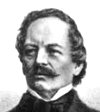 |
|
and medical doctor who discovered Welwitschia mirabilis in 1859 in the Namib Desert of southern Angola. The story goes that he was so overcome by his find that he knelt down next to it and simply stared! Welwitsch sent the first material of Welwitschia to Sir Joseph Dalton Hooker, director of Kew, in 1862. Hooker described it in the family Welwitschiaceae and named it in 1862 in honor of Welwitsch, despite the fact that Welwitsch recommended that it be named Tumboa, its native Angolan name. It is a unique plant and has the longest-lived leaves (1,500-2,000 years) in the plant |
kingdom. Welwitsch was born at Maria Saal in the Duchy of Carinthia, Austrian Empire. His father was a wealthy local judicial official and town councilor of Salzburg. He grew up speaking German like his mother and received a good education including studies in botany. His father led long walks in the woods and helped him identify plants. Despite an obvious interest and facility for the natural sciences, his father nevertheless steered him into attending the Faculty of Law at Vienna University. Frederick’s will held out however and he found himself studying medicine and botany in Vienna and working as a physician in the Austrian provinces of Carniola and Moravia, although he was cut off from his family’s wealth. His interest in the plant kingdom, where he discovered a number of plants hitherto unknown, was so great that in 1839 he abandoned the medical profession altogether. After the mayor of Vienna awarded him at the age of 28 a prize for a paper on the cryptogamic flora of southern Austria, realising that his son was flourishing in his self-chosen field, his father welcomed him back into the fold. He worked as a traveling tutor for a noble family before he graduated in 1836, and then was commissioned by the Unio Itineraria, a German scientific society in Württemberg, to collect in the Azores and Cape Verde Islands and to remit specimens. In 1839 he left Austria never to return. He arrived in Lisbon but his journey onward was delayed by bad weather. He never reached the Azores, but instead spent the time collecting thousands of specimens, learning Portuguese, and ended up remaining in Portugal for 14 years. He sent some 56,000 specimens back to the Unio Itineraria. He was the author of Some notes upon the cryptogamic portion of the plants collected in Portugal (1853). During this time he managed the botanical gardens both at Coimbra and Lisbon, and supervised the Duke of Palmella's gardens throughout the country. He became friends with the King, Pedro V, and when the government decided to send a naturalist to explore their territory in present day Angola, Welwitsch was the first name that came to mind. He arrived in the capital of Angola in 1853. He spent nine years there struggling with tropical diseases and an insufficient salary which forced him to sell duplicate specimens to London. He published an important contribution to the flora of Angola while in Africa, Apontamentos phyto-geographicos sobre a Flora da Provincia de Angola (1857). It was while he was in Angola that he discovered the bizarre plant that bears his name, a plant that has only a pair of leaves that can live for many hundreds of years. He also discovered Rhipsalis baccifera which is the only cactus species occurring outside the New World and which was likely transported to Africa either by migratory birds, floating vegetation, or on early ships. He returned to Portugal in 1861, but decided to go to England to study his 10,000 specimens at Kew and the British Museum. He also had a zoological collection of 3,000 specimens. Although he was assisted by Hooker, who was head of Kew, his relationship there deteriorated. They were not satisfied with his level of publication, although he did release Fungi angolense in 1868 and his one particularly substantial work, the Sertum Angolense (1870). His funding was cut off, and after a fire nearly destroyed his specimens, repeated bouts of illness and the pressures of poverty assailed him, and he died in 1872. Controversies ensued between Kew and the Portuguese government but were finally settled, and his specimens were a vital resource for the authors of the Flora of Tropical Africa at the British Museum with some 1,000 types having since been identified in his collection. He was buried in the Kensal Green Cemetery. He has one family, six genera and 300 species of plants, as well as 29 animal species, named for him. The genus Welwitschia was published by Joseph Dalton Hooker in 1862.
- wen'zel: named possibly after an orchid collector named Chester A. Wenzel (1882-1929) in the Philippines in the first half of the 19th century. Lophozia wenzelii is called Wenzel's notchwort.
-
werneriifo'lius: with leaves like genus Werneria, which was named for the German geologist Abraham Gottlob
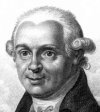 |
|
Werner (1749-1817). He was born in Wehrau in Prussian Silesia. His family was involved with the mining industry and his father was a foundry foreman. He clearly was destined to follow in the footsteps of his family and he was educated at Freiberg and Leipzig, where he studied law and mining, and was then appointed as Inspector and Teacher of Mining and Mineralogy at the small, but influential, Freiberg Mining Academy in 1775. He published the first modern textbook on descriptive mineralogy, Von den äusserlichen Kennzeichen der Fossilien (On the External |
Characters of Fossils, or of Minerals; 1774). He set out an early theory about the stratification of the Earth's crust and demonstrating chronological succession in rocks. He propounded a history of the Earth that came to be known as Neptunism, the theory that the Earth was originally covered by water from which precipitated all the rocks and minerals of the present age. He has been called the "father of German geology" and his fame as a teacher spread widely and attracted students from all over Europe, and many of them went on to have significant careers. He was elected a foreign member of the Royal Swedish Academy of Sciences in 1810. He had been in frail health for most of his life and died at Dresden of internal complications.
-
weston'ii: named for Edward Roy Weston (1885-1966), a draftsman, amateur photographer and botanical collector. The following entry is quoted with minor alterations from Cantelow and Cantelow, "Biographical Notes on Persons in whose Honor Alice Eastwood Named Native Plants," (1957) in Leaflets of Western Botany 8 (5): 83-101: "Weston, Edward Roy. Geological draftsman; born in Dayton, Ohio, 17 Apr.1885, who resided in San Francisco, California He came to California from Idaho in 1915; his love of the out-of-doors led to the popular sport of hiking in Marin County, and it was thus that he 'had the pleasure and honor of meeting Miss Alice Eastwood.' He was chiefly engaged in map making for the State Mining Bureau, War Department, and many oil companies and made excursions to remote spots in California in search of rare plants, sometimes in company with Alice Eastwood." Ernest Twisselman in A Flora of Kern County adds that he was a draftsman with the Shell Oil Co. and collected in Kern County in 1925 and 1926 while living in Bakersfield, making "carefully prepared specimens as vouchers for his photographs of plants."
-
Wheelerel'la: named for Walter Wheeler (1866-1904). He was a native of Massachusetts and had been a resident of Covina, California, for over 12 years when he was struck and killed by a bolt of lightening on Mt. San Gorgonio. He was in the company of local botanist George Grant of Pasadena and a guide, John W. Dodds. Wheeler was killed instantly and his body badly mangled. Grant and Wheeler were on an expedition to the top of what was commonly called ‘Old Grayback’ to collect rare plants for Grant’s collection. After being warned about inclement weather by the guide, Wheeler stopped to examine a flower with a large magnifying glass rimmed with metal when he was struck. As is often the case, two articles in the Los Angeles Times, published only two days apart, give conflicting information. In one the guide is identified as Charles Dodds, and in the other as J.W. Dodd. Also, one article says they were hurrying down the mountain, and the other says Wheeler was struck at the summit. Other discrepancies between the two articles, were that one said their apparently lifeless bodies were found by a mountaineer named Carlson, and the other said they were helped by a newspaperman named Chapman, and further that one said both Grant and guide were rendered senseless, while the other did not indicate that was the case. Nevertheless, it was a catastrophic development, and the retrieval of Wheeler’s body was a nightmare, conditions on the mountain having been made very much worse by the storm, and Wheeler’s body being literally frozen by the time it reached Redlands. Dobbs, a long time mountain man, prospector and guide, had come to California from Texas and lived in a log cabin on the mountain. Grant is quoted describing the incident (1904): "It was as black ... as smoke from a locomotive funnel. I never thought of lightning, and I don't think the others did. What we were afraid of was a hurricane or hailstorm. Suddenly there was a crash of thunder and a blinding flash. The bolt stunned the guide and sent him plumb crazy, so I had to hold him on the ground for half an hour, or he would have thrown himself off the mountain. A second bolt that followed killed Wheeler instantly, ripping his clothes to shreds and leaving him almost naked. Then a third bolt struck close to me while I was struggling with Dobbs, who cried like a baby and was calling for his mother. I couldn't make him realize what had happened. Other bolts followed striking here and there on neighboring buttes, and there was a dead man and a lunatic on my hands, and no help so far as I knew within a dozen miles and the mountain wild with storm." Grant and Dobbs experienced a long and harrowing rescue and survived but understandably ever after, or so it was told of Dobbs, "the sight of lightning unmans him." (from a website of the Sierra Club Hundred Peaks Section) The genus Wheelerella was published by George Bernard Grant in 1906. Incidentally, there is a record in the Indiana University Herbarium of a taxon Aquilegia formosa var. truncata collected 1904-07-23 on Mt. San Gorgonio by George B. Grant, so that is undoubtedly the George Grant who was with Wheeler when he was killed and the George Bernard Grant who published the name Wheelerella.
-
wheel'eri: named for George Montague Wheeler (1842-1905). He was
born in Massachusetts and graduated from the
 |
|
United States Military
Academy in 1866, becoming Lieutenant and a member of the US Army Corps of Engineers. He was
director of US Army surveys of the western US 1869-1879 during
which he explored and mapped the deserts of the Great Basin south
of the 40th parallel to the Mexican border, mapping in total almost
one-third of all the land west of the 100th meridian, including parts
of Arizona, New Mexico, California, Nevada, Utah and Colorado. His
surveying actually began when he was assigned the job of making a
geographical reconnaissance of central |
Nevada, and two years later he became the superintending engineer of the Geographical Survey of
the territory of the United States west of the 100th meridian at the
head of a group of scientists and surveyors. During his first major
expedition, he explored and mapped some 72,000 square miles of territory,
including the Death Valley and Mojave Desert regions. His detachments
again surveyed the Death Valley and Mojave Desert areas in 1875, recording
data on archeology, geology, botany, zoology, and Native Americans,
and made extensive topographic maps of the region. He was promoted
to Captain in 1879 and retired from active duty in 1888. Numerous
mountain peaks and other geographical features are named for Wheeler,
including Wheeler Peak, the highest point in New Mexico. There does not appear to be any relation between George Montague Wheeler and the previously listed Walter Wheeler.
-
wherrya'na: named for Edgar Theodore Wherry (1885-1982), an American mineralogist, soil scientist and botanist. He
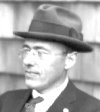 |
|
was born in Philadelphia, Pennsylvania, and his father was the owner of a small printing shop. Edgar was educated at the Friends Central School from 1897 to 1902 and attended lectures at the nearby Wagner Free Institute of Science. He received a 4-year scholarship and enrolled at the University of Pennsylvania where he earned a bachelor’s degree in chemistry in 1906 and a PhD degree in mineralogy in 1908. He taught at Lehigh University from 1908 to 1913, when he moved to Washington, DC to work as an assistant curator of mineralogy for the US National Museum, |
and also for the Bureau of Chemistry of the United States Department of Agriculture beginning in 1917. He was married to E. Gertrude Smith in 1914. With no botanical training, he became interested in the relationship of plants to underlying rock and published his first ecological paper on this subject. He undertook studies in soil acidity, and the identification of minerals by optical-crystallographic properties, becoming the first official in the world with the title of crystallographer. Studies of blueberries and huckleberries led to the publication of his first book, The Wild Flowers of Mt. Desert Island, Maine, in 1928. The many photographs he made and printed on water-colored glass lantern slides were utilized in lectures to garden groups and associations across the Northeast spread his reputation as a botanist widely. He remained in Washington until 1930 when he was invited to begin teaching botany at the University of Pennsylvania, a position he held until his retirement as professor emeritus in 1955. He was especially interested in carniverous plants. A website of the USGS includes the following: “During this period he developed a State Wild Flower Preserve, served as president of the American Fern Society from 1934 to 1938, reorganizing its affairs, and published in 1937 a booklet Guide to Eastern Ferns, founded a new periodical, Journal of the American Rock Garden Society in 1942, and helped revivify that organization. In 1948, he prepared The Wild Flower Guide and was made honorary national president of the Wild Flower Preservation Society. In 1955, he published a major taxonomic revision, The Genus Phlox. This was followed by The Fern Guide of 1961, the Southern Fern Guide of 1964, and, in 1979 Atlas of the Flora of Pennsylvania.” Edgar was elected to the Washington Biologists’ Field Club in 1917, became a non-resident member in 1931, and was awarded an honorary membership in 1974. He was never a man of means, but often underwrote the costs of his field trips and other investigations from his own pocket. In 1961, he donated all royalties from his newly published book, Fern Guide, Northwestern and Midland States, and adjacent parts of Canada, a popular and still standard field manual, to the American Fern Society, and rescued that organization from its perennial financial doldrums. ln 1964, he added to that contribution all royalties from his Southern Fern Guide, a handbook of more limited circulation. Also in 1964, he was awarded the Mary Soper Pope Memorial Award in botany. Earlier, in 1948, Wherry had donated all proceeds from his newly published Wildflower Guide to the financially struggling National Wildflower Preservation Society.
-
whilton'ae/whilton'iae: named for Ynez Ena Whilton (Mrs. John Raymond Winblad) (1907-2003), botanist, naturalist,
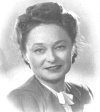 |
|
taxidermist and collector of plants and birds. She was born in Little Rock, Arkansas, and moved to Los Angeles. She assisted her father, Emory Whilton, in collecting and mounting wild flowers, birds, and mammals; many of them occupied the walls of his hotel in Tulare, Calif. These specimens are now housed in the Kern County Museum, Bakersfield, Calif. Over 1,300 botanical specimens are in the California Academy of Sciences where they were sent for determination from 1935 to 1938. Many of her collected plants were sent to John Thomas Howell for identification. |
She died in Contra Costa County, California.
-
Whipp'lea/whipplea'num/whipplea'nus/whipp'lei: named for Lt. Amiel Weeks Whipple
(1817-1863), a topographical
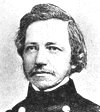 |
|
engineer and surveyor who was in command of the Pacific
Railroad Survey from Fort Smith, Arkansas to Los Angeles in 1853 and
1854 searching for a potential route for a transcontinental railroad.
The route basically followed the 35th parallel across present-day
Oklahoma, the panhandle of Texas, and what is now New Mexico and Arizona.
The expedition consisted of about seventy men, soldiers, teamsters,
herders and a number of scientists from the Smithsonian Institution
including John M. Bigelow as surgeon and botanist, and the young Joseph
C. Ives who later would |
survey the Colorado River through the Grand Canyon. They took measurements, recorded geological data, collected
plant samples and other specimens, and had numerous contacts, mostly
friendly, with members of a number of western indian tribes. His expedition
demonstrated the feasibility of the 35th parallel route for a transcontinental
railroad, and despite the fact the cross-country railroad eventually
followed a different route, the Atchison, Topeka and Santa Fe Railroad
did follow much of his trail from Albuquerque to Los Angeles. This
route would also eventually become that of the famous Route 66. Whipple
was born in Massachusetts, and after a year at Amherst College graduated
fifth in his class from the US Military Academy at West Point. After
being commissioned into the Artillery branch of the Army, he was transferred
to the Topographical Engineers, where he spent several years doing
hydrographic surveys in different parts of the country. He worked
on a survey of the northeast boundary of the United States, then became
an assistant with the US Boundary Commission where he helped survey
the new boundary with Mexico west from El Paso to the Pacific. At
the outbreak of the Civil War, he drew the Union Army's first maps
of the Northern Virginia military region and was chief topographical
engineer for General Irvin McDowell. He took part in the battles of
First Manassas, Fredericksburg and Chancellorsville. He was wounded
in the stomach during the latter engagement on May 4th, 1863 and died
several days later. He had met and become friends with President Lincoln,
who signed his promotion to Major-general just before he died. His
son, Charles William, received a presidential appointment to West
Point and graduated in 1868. The genus Whipplea was published by John Torrey in 1857. (Photo credit: Find-a-Grave)
- white'ae: named for Mary Ellen Seyfferth (Mrs. Homer White) (1865-1965).
-
whited'ii: named for Kirk Whited (1852-1931), a nationally-known amateur botanist, lawyer and farmer whose plant specimens, field notes and other botanical work grace universities and museums across the country. He was born in Michigan and placed in an orphanage when his father was killed in the Civil War. As an adult he lived in Iowa and Nebraska before moving to Wenatchee, Wash., where he eventually served as city attorney before moving to Central Oregon. He had practiced botany in Washington, but it was central Oregon that drew his main interest. He collected plant specimens throughout eastern Washington and Oregon, sending his findings to academics at Washington State University, the University of Oregon and Stanford University. He discovered new plants, with around 20 species named for him. His specimens are in several university herbariums across the country, and dozens are in the Smithsonian's collection. He ranged widely to find his specimens. Hall quotes a 1921 report in The Redmond Spokesman that says Whited was stranded near the crags of Broken Top, where he was examining wildflowers, when his mule died. He finished his work and then pulled his own cart back to his home near Redmond, requiring four days for the journey. He apparently left the Central Oregon area after about 25 years but it is unclear where he moved. He died in Florence Township, St. Joseph County, Michigan. (ref. Astragalus whitedii)
-
Whitlav'ia/whitlav'ia: named for Francis Whitla (1783-1855), an Irish lawyer, friend of W.H. Harvey, member of the Botanical Society of London. Moorea, the Journal of the Irish Garden Plant Society, provides this: "Whitla was elected a life member of the Royal Dublin Society (RDS) in 1839, at which time he was a solicitor in Dublin. In 1840 he was resident in Belfast, and his address in RDS records was given as Ben Edan, Co. Antrim. In the years 1841–55 he was a member of the RDS Botany Committee, Natural History and Museum Committee and Executive Council. He was also a council member of the Royal Horticultural Society of Ireland. He contributed to J.T. Mackay’s Flora Hibernica (1836) and George Dickie’s Flora of
Ulster (1864). Given Harvey’s lifelong friendship with William Hooker and the botanical collaboration among Harvey, Mackay and Whitla, it is not surprising that they contributed to the publication of The Rhododendrons of Sikkim-Himalaya. Being a curator of a Botanic Garden, Ferguson would likely have known Harvey and Mackay, as well as his fellow Belfast-resident Whitla." The genus Whitlavia was published by William Henry Harvey in 1846.
-
Whit'neya/whit'neyi: named for Josiah Dwight Whitney (1819-1896), a state geologist of California from 1860 to
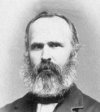 |
|
1876, who made the first geologic study of Yosemite Valley, and for whom Mt. Whitney was named. He was born in Northampton, MA, the oldest of 12 children. He was educated at a series of schools in Northampton, Plainfield, Round Hill, New Haven and Andover. In 1836 he entered Yale University where he studied chemistry, mineralogy and astronomy. After graduation in 1839, he continued to study chemistry in Philadelphia, and in 1840 he joined a geologic survey of New Hampshire as an unpaid assistant to Charles T. Jackson. He was about to enter Harvard Law School |
when a lecture he attended by Charles Lyell turned his life in the direction of science. In 1842 he sailed for Europe where for five years he traveled through Europe and studied chemistry and geology in France and Germany. He became a mining consultant and wrote Metallic Wealth of the United States which was a standard reference for 15 years. In 1860 he became state geologist of California and carried out a comprehensive geologic survey of the state, a survey in which Clarence King, James Graham Cooper and William H. Brewer participated, and which covered not only geology and geography, but also botany, zoology, and paleontology. Although funding for the survey was discontinued in 1868, he remained state geologist until 1874. Whitney wrote The Yosemite Book, published in 1869, which was essentially a travel guide to Yosemite Valley and surrounding regions. He believed that Yosemite Valley was created by a cataclysmic sinking of the valley floor and got into a major fight with John Muir who correctly deduced that it had been carved by glacial action. His hypothesis was never accepted. Another controversy he became embroiled in involved the Calaveras Skull which he declared was millions of years old but which in reality was probably only as old as 1,000 years. In 1874 he went to Harvard and opened a school of mines which a year later became part of the Lawrence Scientific School, and he remained as a professor of geology there for the remainder of his life. Aside from Mt. Whitney, the highest point in the United States, the first confirmed glacier in the US was named for him. He died in New Hampshire. The genus Whitneya was published in 1865 by Asa Gray. (Photo credit: Find-a-Grave)
-
wiegand'ii: named for Karl McKay Wiegand (1873-1942), an American botanist born at Truxton, New York, the son
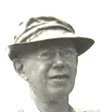 |
|
of a pharmacist. He became interested in the flora of his region as a boy and visited many hills, valleys and swamps in the Tioughnioga Valley in search of interesting plants. He entered Ithaca High School with the idea of enrolling at Cornell University for a course in pharmacy. That course was eliminated just before he entered and he switched to botany which was his eventual major, graduating in 1894 with a BS degree. He then became an assistant in the department of botany and continued his study as a graduate student, receiving a PhD in 1898. The following year he was elev- |
ated to instructor, a position he held until 1908. He was initially interested in physiology, anatomy and morphology, but in 1900 he began teaching taxonomy and that became his main field of work. At that time he went to Wellesley College as associate professor of botany where he taught elementary botany and taxonomy until 1913 when he returned to Cornell as professor of botany in the College of Agriculture. Dr. Liberty Hyde Bailey was at the time dean of the College and he selected Wiegand to be the head of a newly organized department of botany. Wiegand remained head of this department until his retirement. He taught classes in the laboratory and in the field, conducted research, and built up from scratch a herbarium of 250,000 specimens. During the course of his time at Cornell he published more than a hundred papers including Cayuga Lake Flora which was prepared along with Dr. Arthur Johnson Eames. He also made significant contributions to Bailey’s Standard Cyclopedia of Horticulture. A website of Cornell University adds the following: “He was recognized as one of the leading taxonomists of the world. In 1933 he was vice-president of Section G of the American Association for Advancement of Science and in 1939 president of the Botanical Society of America. He has served the University on many important committees, notably the Arboretum Committee, the Committee on Campus Trees, and the Committee on the Bailey Hortorium. He was chairman of the last two committees for several years, and to the work of all of these committees he gave much time and thought. In 1923, in view of the large attendance of summer students in the biological fields and the richness of the Ithaca region in biological material, a Summer School of Biology was established under the auspices of the Summer School of the University and the Summer School of the New York State College of Agriculture. Dr. Wiegand was in large measure responsible for the initiation of this new school and directed the school throughout the eleven years of its existence. Dr. Wiegand was a very modest man, unselfish in high degree. He viewed his administrative problems, as he did his research problems, objectively. He was always ready to forsake his own views when convinced of the validity of the concepts of others. His research was conducted with the utmost patience and marked by the most careful and intelligent procedure based on exact knowledge. His quiet cheerfulness, his high ideals, and his thoughtful consideration of others endeared him to his students, to all members of the department, to his colleagues, and to all who were associated with him.” (Photo credit: Bailey Hortorium Herbarium at Cornell University)
- wiens'ii: named for Delbert Wiens (1932- ), “American botanist from Munich, North Dakota, who was trained at Pomona College, Claremont, California (BA, 1955), University of Utah, Salt Lake City (MS, 1957) and Claremont Graduate School, California (PhD, 1961). A specialist in Loranthaceae and Viscaceae, including systematics, biogeography and evolution of the families. He was appointed instructor (1960-1962) in the biology department of the University of Colorado, Boulder and later assistant professor (1962-1964). He was Fulbright fellow at the University of Guayaquil, Ecuador (1964) before returning to the United States as associate professor (1964-1974) of the biology department, University of Utah, Salt Lake City, and subsequently professor from 1974 until his retirement. He collected in South Africa (1972, 1973) and was based at the Botanical Research Institute (PRE) from March to September, 1976. Delbert Wiens published Mistletoes of Africa (1998) with Roger Polhill, including many new species and combinations of African plants.” (Quoted from JSTOR). He was the director of the herbarium at the University of Utah. The genus Delwiensia was also named for him.
-
wier'i: named for Daniel Byrne Wier (c. 1834-1893), fruit nurseryman and writer on horticulture and nature. He was born in Marshall County, Illinois, and wrote under the pen name 'Byrne.' He was the horticultural editor of the weekly 'Orchard and Farm.' He came to Petaluma around 1890 and died in San Francisco.
-
wieria'na: named for Harold Allen Wier (1952-2001). A website of the Anza Borrego Foundation supplies a few
 |
|
meager details: “Harold A. ‘Howie’ Wier (1952-2001) was a native San Diegan and a lifelong naturalist. He worked as a biological consultant and conservation biologist throughout Southern California. He was active in the California Native Plant Society, a past president of San Diego Audubon and a long-time member of the Anza-Borrego Foundation. This grant [the Howie Wier Memorial Conservation Grant] program was established by Anza-Borrego Foundation with the help of Howie’s family, friends and colleagues as a fitting tribute to Howie’s passion.” |
-
wiesland'eri: named for Albert Everett Wieslander (1890-1992), a California
forester who was responsible in the 1930s for surveying California
vegetation and creating the Vegetation Type Mapping Project. "The
ultimate goal of the original VTM project was to create vegetation
type maps, but in the process the surveyors collected several other
kinds of data as well. In order to validate some of the broad zones
of vegetation they designated from high vantage points, the surveyors
also ran vegetation transects, collecting data on species composition,
depth of leaf litter, and tree size, among other things. They marked
the location of these plots on USGS topographic maps, which today
provide us with point occurrences of the individual species they found.
Additionally, they collected sample specimens and placed them in the
University Herbarium (now the Jepson Herbarium), many of which remain
there today. They also took photos of many vegetatively distinct locations,
and marked the locations of these photos on maps (unfortunately most
of these photos maps have been lost). And finally, of course, they
created vegetation maps, drawing broad zones of single or mixed stands
in crayon over USGS topographic quads. Originally, the project was
slated to included detailed vegetation type maps of 220 USGS quadrangles,
but the survey was halted by World War II, and only 23 maps were published.
The project continued after the war under state funding, but no more
quads ever saw publication. However, much of the unpublished data
survives today and exists in storage at the University of California,
Berkeley. The VTM dataset has been recognized as an invaluable window
into the state of California flora in the early 20th century, and
has provided data for several graduate theses at the University. However,
the dataset's physical fragility and resultant restriction to the
UC Berkeley campus have made it largely inaccessible to the broader
scientific community. Thus, researchers at UC Berkeley Department
of Environmental Science, Policy, and Management (ESPM), in conjunction
with the Marian Koshland Bioscience and Natural Resources Library,
sought funding to digitize all of the published and unpublished dataset,
for use in modern geographic information systems and to facilitate
its distribution via the Internet." This information is quoted
from a Berkeley website and through this site the digitized material is now largely available
to the public.
-
Wigan'dia: named for Johann (Johannes) Wigand (1523-1587), a Prussian writer on plants, professor of theology and
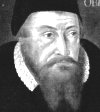 |
|
Bishop of Pomerania. He was born at Mansfeld in Saxony-Anhalt, Germany, into a Lutheran family. He studied at the University of Wittenberg and attended lectures by Martin Luther. He was a main contributor to the Magdeburg Centuries, a critical work on church history. In 1545 he graduated with a Master’s degree. The following year he became a pastor in his hometown and then in 1553 was appointed pastor of the Church of St. Ulrich (Sankt-Ulrich-und-Levin-Kirche) in Magdeburg. He turned to academia and became professor of theology at the University of Jena and in 1563 was |
awarded a doctorate of theology from the University of Rostock. He was forced to leave the territory when August of Saxony took over the administration of Saxe-Weimar in 1573, and went to Königsberg in East Prussia where in 1575 he became Bishop of Pomesania, a post he held until his death in 1587. The genus Wigandia was published in 1790 by Noel Martin Joseph de Necker.
-
wiggins'ii: named for Ira Loren Wiggins (1899-1987), an American botanist, author of Flora of Baja California, A
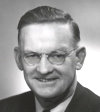 |
|
Flora of the Alaskan Arctic Slope with John Hunter Thomas, and the two-volume Vegetation and Flora of the Sonoran Desert with Forrest Shreve. He was born in Madison, Wisconsin, and attended Occidental College with the intent of becoming a Presbyterian minister, graduating with a BA in philosophy in 1922. He taught school for a year, however his interests changed to botany and he then received his MA at Stanford where he studied with LeRoy Abrams. From 1925 to 1927 he was an instructor at Occidental College. He got a PhD in 1930 and wrote his thesis on the flora of San |
Diego County. He joined the Stanford faculty in 1929 and remained there until he retired in 1964. After retiring from Stanford as professor of biology emeritus, Wiggins continued teaching at California University, Fullerton, and the University of Florida, as well as researching and writing papers. He was the curator of the Dudley Herbarium and director of the natural history museum (1940-1962) at Stanford University. He was the first recipient of the Fellow's Medal of the California Academy of Sciences, and a fellow of the Arctic Institute of North America and the California Academy of Sciences. Professor Wiggins made over 50,000 collections of plants as well as major contributions to zoological collections. He undertook an expedition in 1964, taking part in the Galapagos International Scientific Project studying the flora of the islands made famous a century before by Charles Darwin, and culminating witth The Flora of the Galapagos Islands (1971). He collected plants extensively in the Sonoran Desert and wrote about desert flora. His name is also on two species of lizards. He died in Palo Alto in late 1987.
-
wight'ii: named for William Franklin Wight (1874-1954), an English botanist who specialized in the flora of India. He moved to the United States in 1899 and became a botany assistant at Stanford University. From 1900 he was a USDA researcher in studies on agriculture, genetic improvement of fruit trees, taxonomic pomology, and Alaskan flora.
-
wilcox'ii: named for plant collector Ernest Norton
Wilcox (1869-1961). From the San Luis Obispo Telegram-Tribune, 4 Sep.
1961: "Mr. Wilcox was born on March 27, 1869 in Thawville, Ill.
When 15 he accompanied his family to South Dakota where they homesteaded
for a number of years. He graduated from South Dakota State College
at Brookings and worked for a time with the US Department of Agriculture.
In 1903 he was married to Emily B. Sprague of Thawville, and [he]
farmed in that vicinity until 1919 when he moved to Atascadero Garden
Farms. In 1940 he came to San Luis Obispo to reside with his son-in-law
and daughter, Mr. and Mrs Charles V. Gates. In addition to watercolor
art, Mr. Wilcox was interested in his large collection of tropical
and fossil shells, some of which were presented recently to the Cal
Poly and County Museum Association. He was a member of the Gem and
Mineral Club, San Luis Obispo; the Conchological Club of Southern
California, and the San Luis Obispo and Morro Bay Art Associations."
David Hollombe adds that he "worked for the Agrostology Division
of the USDA and collected plants in Montana and adjacent states. He
has often been confused with the better-known Earley Vernon Wilcox."
( Eriastrum
wilcoxii)
-
wilcox'ii: named for Timothy Erastus Wilcox (1840-1932), a US Army Brigadier General and plant collector. He was
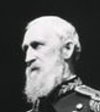 |
|
born in Litchfield, Herkimer County, New York, and was awarded an AB degree from Union College in Schenectady in 1861 and an AM degree from the same institution in 1864. He also received an MD from Albany Medical College. He served in the Civil War as an assistant surgeon in 1865 with the 6th New York Heavy Artillery. He resigned from the Army in 1868 but later returned again as an assistant surgeon. He participated in the Sheepeater Indian War of 1879 in Idaho, which was the last Indian war fought in the Pacific Northwest portion of the United States. In |
1891 he was promoted to Major Surgeon and later was at Pine Ridge Agency after the battle of Wounded Knee. He was posted to Fort Huachuca, Arizona, from May, 1891 to May, 1895, where he was the post surgeon and spent a portion of his time making botanical and zoological collections for the herbarium of Columbia College and the United States National Museum, respectively. In 1898 he became Lt. Colonel Chief Surgeon of Volunteers during the Spanish-American War, and in 1901 deputy surgeon general of the US. He retired with the rank of Brigadier General and died in Arlington, Virginia and was buried at the National Cemetary. ( Quercus wilcoxii) (Photo credit: Find-a-Grave)
-
wild'erae: named for Charlotte May Wood Thurber Wilder (1866-1957), wife
first of Eugene Carleton Thurber and then of Harry Edward Wilder,
American botanist who collected in the San Gabriel Mts of Southern
California. She was born in Utuca, New York, and died in Scotia, California. Her first husband was a field naturalist who visited the San Pedro Martir in Baja California from April-June of 1893 with Alfred W. Anthony, Wilfred W. Anthony, T. S. Brandegee and Harry E. and Charlotte M. Wilder, botanizing on Isla Guadalupe. His name is on the Thurber's dark-eyed junco.
-
wilkes'ii: named for Charles Wilkes (1798-1977), an American naval officer, ship's captain, and explorer. He was born
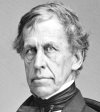 |
|
in New York City. His mother died when he was just three, and he was raised by an aunt who would later convert to Roman Catholicism and become the first American-born woman canonized a saint by the Catholic Church. After she was widowed, Charles was sent to a boarding school, and later attended Columbia College, present-day Columbia University. He entered the United States Navy as a Midshipman in 1818, and became a Lieutenant in 1826. The Encyclopedia Britannica says: “… in 1830 [Wilkes] was placed in charge of the depot of instruments and charts from which the Naval |
Observatory and Hydrographic Office developed. From 1838 to 1842 he commanded an exploring and surveying expedition that took him ultimately into the Antarctic Ocean and along the Antarctic barrier, where he reported land at a number of points in the region subsequently known as Wilkes Land. He visited islands in the Pacific, explored the west coast of the United States, then recrossed the Pacific and reached New York in June 1842, having sailed completely around the world. He was advanced to the rank of Commander in 1843. From 1844 to 1861 he prepared the report of his expedition, writing himself 7 of its 19 volumes.” A website called Historical Seaport says: “In 1841, Wilkes mapped portions of the west coast of North America. Entering Puget Sound, he dropped anchor in Discovery Bay on the Strait of Juan de Fuca 50 years to the day after Capt. George Vancouver visited the area. Wilkes sailed south in Puget Sound and surveyed much of the estuary, including naming Elliott Bay, the deep water harbor for Seattle. While in Puget Sound, he learned of the loss of the sloop-of-war USS Peacock, which foundered on the Columbia River bar, though most of the scientific samples and drawings were saved. Wilkes eventually traveled overland to San Francisco Bay, which he declared one of the finest harbors in the world, along with Puget Sound.” He was assigned to the San Jacinto during the Civil War and was involved in an international incident involving the British mail steamer Trent. Later he was court-martialled for insubordination and conduct unbecoming an officer and suspended from duty as a result of of neutrality violations from several foreign governments. Despite this he was commissioned Rear Admiral, and retired in 1866. The Wilkes Expedition of 1838-1842 was the most important expression of the US’s international aspirations which established the country’s naval and scientific interests in the Pacific Ocean. Wilkes was the author of Western America, Including California and Oregon (1849), Voyage Around the World (1849), and Theory of the Winds (1856). The publication of Wilkes' detailed map of the Oregon Territory gave Americans a new image of that unknown land, but upon his return Charles Wilkes faced a somewhat indifferent Congress, an apathetic public, and criticism from former expedition officers. In fact, courts-martial were held over Wilkes' alleged excessive zeal with the cat-o'-nine-tails and other matters, but nothing came of the inquiries. He died in Washington, DC, and is now interred at Arlington National Cemetary. (Photo credit: On This Day)
-
wilkinsia'na: named for Lewanna Wilkins (1869-1955), American botanist, teacher, taxonomist
who collected plant specimens as part of the US Biological Survey to Mt.
Shasta led by Clinton Hart Merriam. She was born in Fairfax County, Virginia, nd died at Washington, DC. She received a Bachelor of Arts degree from Wellesley College. She was a member of the Biological Society of Washington, the Wild Flower Preservation Society of America, and the National Geographic Society, and she was affiliated with the Smithsonian Institution.
-
willdeno'vii/willdenowia'na/willdeno'wii: named for Carl Ludwig Willdenow (1765-1812), an eminent German
 |
|
botanist and taxonomist who was director of the Berlin Botanical Garden 1801-1812 and who in his multi-volume Species plantarum published many of the new species discovered by Gotthilf Henry Muhlenberg. He was born in Berlin and studied pharmaceutics at Wieglieb College, Langensalza, completing those studies in 1785. He also studied medicine and botany at the University of Halle, graduating in 1789 with an MD. His father ran a pharmacy in the Unter den Linden and when Carl was done with his schooling he worked for his father. By this time he was intensely interested in |
botany and in 1787 was published his Florae Berolinensis prodromus. In 1790 he took over his father’s pharmacy which he operated until 1798. In 1792 he published Principles of Botany and two years later was admitted to the Berlin Academy of Sciences. In 1798 he was made professor of natural history at the Berlin Medical-Surgical College and in 1810 a professor of botany at the University of Berlin. Wikipedia says: “He is considered one of the founders of phytogeography, the study of the geographic distribution of plants. Willdenow was also a mentor of Alexander von Humboldt, one of the earliest and best known phytogeographers. He also influenced Christian Konrad Sprengel, who pioneered the study of plant pollination and floral biology. His early interest in botany was kindled by his uncle Johann Gottlieb Gleditsch and he started a herbarium collection in his teenage years. He was a director of the botanical garden of Berlin from 1801 until his death. In 1807 Alexander von Humboldt helped to expand the garden. There he studied many South American plants, brought back by Humboldt. He was interested in the adaptation of plants to climate, showing that the same climate had plants having common characteristics. His herbarium, containing more than 20,000 species, is still preserved in the botanical garden in Berlin. Some of the specimens include those collected by Humboldt.” He died in Berlin in 1812.
-
williams'iae: named for Margaret Jensen (Mrs. Loring Ryder) Williams
(1917-2000), founder of the Northern Nevada Native Plant Society.
David Hollombe provided the following brief note from Arnold Tiehm
in 'Nevada Vascular Types': "Margaret Jensen Williams and Arnold
Tiehm collected the type of Eriogonum ovalifolium var. williamsiae Reveal in 1979. Williams received bachelor's and master's degrees
from the University of Nevada and for many years was an elementary
school teacher in Reno, retiring in 1981. She has had a long-time
interest in rock gardening, gardens in general, and a strong love
for the Great Basin. A member of the California Native Plant Society
since its early years, she had envisioned such a society for Nevada
and was the moving force behind the Northern Nevada Native Plant Society's
(NNNPS) inception in 1975. She subsequently has served as NNNPS president
and for many years has been its executive director."
-
williams'ii: named for botanist Emile Francis Williams (1859-1929), a Boston oriental rug importer, amateur botanist and Chinese porcelain collector. In 1904 he married Blanche Wheeler, a Smith graduate and teacher at the Wheeler School in Providence, RI. At Smith she studied classical languages, art history, and studio art. She taught Latin, Greek and English at her aunt’s preparatory school in Providence from 1892 until her marriage. A publication by Merritt Lyndon Fernald in Rhodora says: ““During the past July Mr. Emile F. Williams found at Van Buren, Aroostook County, Maine, a singular rush, unlike any of the forms recognized in America. ... The plant, here proposed as a new variety and dedicated to Mr. Williams who was first to call attention to its peculiar habit, is not confined to the St. John valley, as identical specimens were collected at Edgeworth, Maiden, Massachusetts, by the late Wm. Boott in 1853.” Williams died in Cambridge. (Juncus tenuis var. williamsii)
-
williams'ii: named for Robert Statham Williams (1859-1945), an American bryologist. A website of the New York Botanical Garden gives the following biography: "As a boy growing up in Minneapolis, MN, [he] was an ardent naturalist. When he was 20 years old his love of nature took him from Minneapolis to Montana where he became a successful businessman, miner and explorer and for a short while he was a rider for the famous Pony Express. In 1898 during the early days of the gold rush, Williams joined one of the parties going to the Yukon by way of Alaska, where he engaged in business rather than search for gold which also gave him time to collect plants. His plants collected there during 1898 and 1899 represent the first extensive collections made there by a resident naturalist. In 1899, [he] came to the New York Botanical Garden with his collections and determinations. He was appointed museum aid in 1899 which he held in absentia, until January 1906 when he was named assistant curator. In 1910 he became an administrative assistant and in 1932 his title became research assistant in bryology. Williams chose to work on mosses and made a substantial contribution of his own collections of mosses from Alaska and the Yukon. In 1901, [he] accompanied an English land company on a exploration to Bolivia. He returned to NY with an enormous collection of plants from Bolivia and Peru. Later, in 1903 the NYBG sent him to the Philippine Islands. He made large collections which furnished him with enough material to publish an authoritative work on Philippine mosses (1914). His last expedition was to Panama in 1908. In 1909, the NYBG had purchased the William Mitten Herbarium, an important collection of bryophytes containing type specimens of hundreds of new species described by Mitten. Williams was sent to Hurstpierpoint, England, to Mitten’s home, to supervise the packing and shipping of it. [He] was one of the few botanists at the NYBG who could devote himself full time to bryology and was therefore called upon by many botanist for help with identification of mosses. He made every effort to identify these mosses and often prepared meticulously careful drawings to illustrate details. Williams lost his fortune in the 1930s during the financial depression which contributed to his waning health. He eventually lost his enthusiasm for bryology and finally retired to his boyhood home in Minneapolis where he remained until his death on March 13, 1945, at the age of 86." He was also captivated by ornithology and prepared an almost complete set of taxidermied skins of birds from Minnesota. He sold his collection to the Minnesota Museum of Natural History to fund his later explorations, a decision which he regretted later in life. (Elatine californica var. williamsii, Tortula williamsii) (Photo credit: Semantic Scholar)
-
williamson'ii: named for Lt. Robert Stockton Williamson (1824-1882), leader of a railway
survey in the mid-eight-
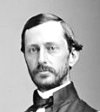 |
|
eenth century. The website Virtual American Biographies says: "[He was] born in New York in 1824; died in San Francisco, California, 10 November, 1882. He was graduated at the United States Military Academy in 1848, assigned to the topographical engineers, and took part in various surveys on the Pacific coast till 1856, when he became 1st Lieutenant. From that time till the civil war he was on the staff of the commanding general of the Department of the Pacific, and in charge of military roads in southern Oregon, with meteorological observations on that coast. On 6 August, |
1861, he was promoted Captain, and, after reconnoissances on the lower Potomac till March, 1862, he was chief topographical engineer in the operations in North Carolina, being brevetted Major, 14 March, 1862, for services at New Berne, and Lieutenant-Colonel on 26 April for the siege of Fort Macon. He then served with the Army of the Potomac, of which he was chief topographical engineer, from 21 November till 21 December, 1862, and held that post in the Department of the Pacific from 9 February till 3 March, 1868, when he was transferred to the Corps of Engineers, in which he was made Major on 7 May. Afterward he served on the Pacific coast as superintending engineer of various surveys of rivers, harbors, and sites for fortifications. On 22 February, 1869, he was promoted Lieutenant-Colonel. Colonel Williamson published Report of a Reconnoissance and Survey in California in Connection with Explorations for a Railway Route to the Pacific in Vol. 3 of 'Pacific Railway Reports' (Washington, 1853), On the Use of the Barometer on Surveys and Reconnaissances (New York, 1868) and Practical Tables in Meteorology and Hypsometry." He made a reconnaissance of the north side of the San Gabriel Mountains for the Pacific Railroad Survey in 1853 and the peak Mt. Williamson was named for him.
-
willis'ii: named for John H. Willis (?- ). Guy Nesom in his "Taxonomic Review of the Erythranthe moschata complex" (Phytoneuron 2017-17) says "This Erythranthe is named for Duke University molecular geneticist John Willis, who has encouraged and mentored many in the study of evolutionary problems approached through monkeyflowers –– his lab a wellspring of monkeyflower momentum." He received his PhD at the University of Chicago in 1991 and from 2000 to 2008 was associate professor of biology at Trinity College of Arts and Sciences. He is currently professor of biology at Duke University.
-
wilsonia'num: named for Norman Chipman Wilson (1869-1948), a plant collector and friend of Edward L. Greene. A web page by Tom Schweick quotes from Jepson’s “Types and Original Citations,” Vol. 1, 181, to wit: “N. C. Wilson traveled from Berkeley to Arizona (or Arizona to Berkeley) by rail over the Tehachapi Range. With characteristic vagueness, Greene says of Ribes wilsonianum ‘mts. of Kern Cty.’ This must have been Tehachapi. I think Wilson botanized only along the railroad in California.” Another source says that he was traveling in the West for his health and collecting plants from Professor Greene. And David Hollombe has provided these further details: “Norman Chipman Wilson, born at Washington IA in Sept. 1869, son of a Presbyterian minister. Shown in the 1870 census at Salinas, CA and in 1880 at Waitsburgh, WA. Later the family was at The Dalles, OR where in 1886 Norman headed the formation of a chapter of the Agassiz Association and advertised in the Association's columns in the St. Nicholas illustrated magazine for exchange of botanical specimens. It appears that in 1892 he was president of the YMCA chapter at the Belmont School in Belmont, CA. By 1894 he had settled at Phoenix, AZ. On 24 March 1897 he married Leona Wooldridge, who died in April 1899. In August of 1900 Norman survived being lost for two weeks after becoming separated from his friends while camping and hunting about fifty miles south of Flagstaff. He later lived in Washington, mostly at Walla Walla, but also at Seattle. He married again about 1916 and became a Christian Science practitioner. He died on Oct. 29, 1948, thirteen days after driving off a 100 foot embankment from Scenic Loop Road in Walla Walla.”
-
win'teri: named for Robert Frank (‘Bob’) Winter (1925-2013). He was born and died in Fresno, California. He was an emeritus Fresno City College instructor who influenced the development of many California biologists and natural historians within and beyond the range of this newly described species, Helianthus winteri. His comment to "look at that big sunflower (blooming in January) up there" eventually prompted this closer analysis of a plant that superficially appeared to be H. annuus. The fact that the plants routinely flower year-round, including the winter months, lends further justification to the specific epithet.
-
Wislizen'ia/wislizen'i: named for Frederick Adolf
Wislizenus (1810-1889), an Army surgeon, explorer, botanist and
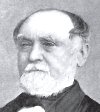 |
|
plant collector of German birth who traveled extensively in the southwestern
United States. The pale leopard lizard, Gambelia wislizeni,
was named for him. The following is quoted from The Cold-Blooded
News (The Newsletter of the Colorado Herpetological Society),
Vol. 30, No. 11, Nov. 2003: "Frederick Adolph Wislizenus was
born in Koenigsee, Schwarzburg-Rudolstady, Germany in 1810. Emigrating
to the United States in 1835 following an unsuccessful student uprising
in which he participated, Wislizenus settled in Illinois near St.
Louis and set up a medical practice. However, |
this physician was not
one to let grass grow between his toes. Succumbing to wanderlust,
he joined a cadre of fur traders traveling the Oregon Trail in 1839.
Wislizenus accompanied them as far as Idaho; then he joined another
party that traveled through Colorado to Bent's Fort on the Santa Fe
Trail, and from there he returned to St. Louis. A result of this journey
was a book entitled A Journey to The Rocky Mountains in the Year
1839. While not a confirmed naturalist, Wislizenus had made the
acquaintance of the celebrated botanist George Engelmann who had instilled
in him the importance of making collections and natural history observations
when traveling. Apparently no herps were collected on this journey.
However, he did describe a "horned frog" that he correctly
identified as a lizard and which appears to have been Phrynosoma
cornutum. By 1846, Wislizenus was ready to go
again. Joining a group of traders, he traveled to Santa Fe and then
on to Chihuahua. This was a troubled time, just before the outbreak
of the Mexican War, and the US Army was suspicious that any party
of traders heading from Mexico might be carrying arms. According to
one account, Wislizenus's group was pursued by an attachment of soldiers
led by Colonel Stephen Kearney, commander of the Army of the West,
but they reached Mexico safely. However, it was out of the frying
pan and into the fire, for they were immediately taken as prisoners
of war by the Mexicans and were interned at a camp in the Sierra Madre
Occidental. Apparently Wislizenus was not considered to be too much
of a threat to Mexican security as he was permitted to wander up to
two leagues away from the prison camp, in order to collect plants,
many of which are still rarities in herbaria. Eventually, he was rescued
by a company of US troops. Indebted to the army for the rescue,
he then joined them for a time as a surgeon before returning to St.
Louis. Sometime during this adventure, Wislizenus collected the type
specimen of the long-nosed leopard lizard. His adventures on this
trip were later published in an 1848 government report entitled Tour
Through Northern Mexico, which included a section by George Engelmann,
describing the unusual plants collected. Following this adventure,
Wislizenus married and settled down in St. Louis. He became a respected
pillar of the community helping to found the Missouri Historical Society
and the Academy of Science of St. Louis. Scientists named several
new species after him. In addition to the long-nosed leopard lizard,
Asa Gray, the famous Harvard botanist, added the legume, Dafea
wislizeni, and Augustine de Candolle, the Swiss botanist, described
an oak as Quercus wislizeni. Presumably, these scientists
thought highly of Wislizenus. However, one need wonder about his mentor,
George Engelmann, who named Wislizenia refracta, the jackass
clover in his honor."
-
Wister'ia: named for Dr. Caspar Wistar (1761-1818),
an anatomist and professor of chemistry and physiology. Wistar
 |
|
was a friend of Thomas Jefferson who had worked with him on identifying fossil remains that Jefferson was interested in, and was one
of those who instructed Meriwether Lewis on the natural sciences in
preparation for the Lewis and Clark expedition. He received
his MD at the University of Edinburgh in 1786, and later served
as staff physician at several Philadelphia area hospitals. He created for instructional purposes a set of life-sized anatomical models, which were actual human remains that were injected with wax to preserve them. He
was an early advocate for vaccinations |
against disease. He almost
died of yellow fever during an epidemic in 1793 while helping others.
He published the first American textbook on anatomy in 1811.
The work, in two volumes, was entitled A System of Anatomy
for the Use of Students of Medicine. He held the chair of
anatomy at the University of Pennsylvania medical school. He
was also president of the American Philosphical Society from 1815
to 1818, and president of the Society for the Abolition of Slavery. His home was a meeting place for students and scientists.
He was particularly interested in botany and paleontology. The
genus Wisteria was named for him in 1818 by his friend, the English botanist
Thomas Nuttall of Harvard, who wrote in The Genera of North American Plants: "In memory of Caspar Wistar MD, ... a philanthrophist of simple manners, and modest pretensions, but an active promoter of science." For some reason the genus name was
spelled 'Wisteria' with an 'e'. This is one of those cases where the genus name and the common name are the same. Occasionally, it is spelled
'Wistaria,' in recognition of the spelling of Wistar's name, as with the famous Sierra Madre Wistaria Festival, and the
plants often carry the common name of Wistaria, but according to the rules of the International Code of Botanical Nomenclature, since the original
name given by Nuttall to the genus was spelled 'Wisteria,' that must remain its
correct Latin name regardless of the inconsistency. It is unclear why Nuttall did not assign a name that was consistent with Wistar's name, but the fact that he published it in the same year that Wistar died is perhaps not a coincidence. Nuttall's biographer Jeannette Graustein wrote in Thomas Nuttall, Naturalist: Explorations in America, 1808-1841 (1967): "Queried about the spelling, Nuttall stated that it was chosen for euphony ["a pleasing or sweet sound, the acoustic effect produced by words so formed or combined as to please the ear"]. However, in the Wister branch of the family Nuttall had a very good friend, Charles Jones Wister, Sr., (1782-1865), often his host and his companion on mineralogical and botanizing excursions." Back in those days, spelling was not as firmly fixed as it is now, and it was not uncommon for different members of the same family to spell their names differently. According to my South African friend Hugh Clarke, "Thomas Nuttall, the botanist who named the genus Wisteria attributed the error to 'euphony' as Wister and Wistar are acceptable American spellings of his original German family name 'Vüster'." The ICBN rules are that the spelling of originally published epithets may be changed for typographic or orthographic reasons, but in this case, seeming to have been a purposeful choice, the spelling is destined to remain as it was.
-
Withering'ia: named for William Withering (1741-1799), an English botanist, geologist, chemist, physician and the
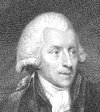 |
|
first systematic investigator of the bioactivity of digitalis. He was born in Wellington, Shropshire, England, and his father was a surgeon. He first apprenticed to a surgeon in his home community, and then trained as a physician and studied medicine at the University of Edinburgh Medical School from 1762 to 1766. In 1767 he was employed as a consultant at Stafford Royal Infirmary and from 1775 he worked at Birmingham General Hospital. He was married to an amateur botanical illustrator in 1772. In 1776 he published The botanical arrangement of all the vegetables naturally |
growing in Great Britain, an early and influential British flora. It was the first in English based on the then new Linnaean taxonomy — a classification of all living things — devised by the eminent Swedish botanist and physician Carl Linnaeus, and became the standard reference for English botany for almost the next 100 years. His wife provided botanical illustrations of the plants he collected. Subsequently, the plant Witheringia solanacea was named in his honor, and he became known on the continent of Europe as "The English Linnaeus." In 1783 he diagnosed himself as having pulmonary tuberculosis and went twice to Portugal hoping the better winter climate would improve his health, but it did not. While at Birmingham General he recognized the medical effectiveness of the active ingredient in the foxglove plant. In 1785 he was elected a fellow of the prestigious Royal Society and also published his An Account of the Foxglove and some of its Medical Uses. He was also an enthusiastic chemist and geologist, and made notable contributions to archaeology. He was a part of a group called the Lunar Society whose members called themselves 'lunatics' and which included such luminaries as Matthew Boulton, Erasmus Darwin, Josiah Wedgwood, James Watt and many others who were equally distinguished. This extraordinary group acted as a ferment to the Industrial Revolution, both locally in Birmingham and nationally in the United Kingdom. They corresponded with Lavoisier in France and Franklin in America, and persuaded the great chemist Joseph Priestley to move from Wiltshire to Birmingham to set up his house and laboratory there and even raised a subscription to fund the equipping of his laboratory where he carried on greatly influential experiments. Withering resigned from his post at Birmingham General in 1792 after his troubles with chronic bronchitis got worse. This process continued over the next seven years until his eventual death at the age of 58. He was a remarkable physician and natural philosopher who, with his fellow lunatics, contributed much to Birmingham and to the world. The genus Witheringia was published by Charles Louis L'Héritier de Brutelle in 1788.
-
Wolff'ia: named for Johann Friedrich Wolff (1778-1806), German botanist, entomologist, physician and natural history illustrator. He wrote and illustrated Commentatio de Lemna and Icones Cimicum descriptionibus illustratae. The genus Wolffia was published in 1844 by Matthias Jacob Schleiden based on a previous description by Johann Horkel.
- wolf'ei/wolfia'nus/wolf'ii: named for Dr. Carl Brandt Wolf (1905-1974),
a botanist at Rancho Santa Ana Botanic
 |
|
Gardens and author on oaks and cypresses. He collected extensively in Kern County, including several
type specimens, and spent many years studying cypresses. He was born in Freesoil, Michigan, and his family moved to Medford, Oregon in 1910, and then to San Diego in 1915 and finally to Eagle Rock near Pasadena in 1916. He graduated from Glendale High School in 1921 and entered Occidental College at the age of 16. After a year he sought some workday experience and he worked for a year at the Theodore Payne Nursery, establishing a close friend friendship with |
Payne that lasted until Payne's death. He returned to college and graduated with an AB degree in botany in 1926. He then entered Stanford and studied under LeRoy Abrams, gaining his MA in 1927. He followed that up with a PhD in 1930, having held a teaching assistantship for most of those years. He conducted extensive field studies in areas ranging from the Canadian to the Mexican border and east into Nevada, Arizona and New Mexico. In 1930 he married and then accepted a post as botanist with Rancho Santa Ana Botanic Garden which was then located in Orange County, remaining there until 1945. During this time he also concentrated on civic service and was on the board of trustees of Fullerton High School and Junior College. He was also a member of the Masonic Lodge and became a Shriner. After resigning from RSABG he became manager of the Sespe Land and Water Company which had been founded by his wife's grandfather. He also started and operated La Cienega Nursery. He died just short of his 69th birthday. (Information from an obituary in Madroño) (Photo credit: Madroño, Vol. 22 No. 8, October, 1974) (Oenothera wolfii, Opuntia wolfii, Mimulus wolfii, Yucca brevifolia var. wolfei, Lupinus wolfianus)
-
Wolffiel'la: a diminutive of Wolffia.
-
wolf'ii: named for John Wolf (1820-1897), a German-born teacher, government assayer, geologist, entomologist, botanical collector in Colorado and Illinois, and author of a list of Illinois mosses, liverworts, and lichens in 1878, who participated in the Wheeler Survey of 1869-1879 where he was assistant to Joseph Trimble Rothrock. He was born in Mittelsinn, Bavaria, into a family of seven children, one sister and five brothers all named John, distinguished only by their middle names. In 1833 the family crossed the Atlantic in a sailaboat and settled near Bedford, PA. After starting out as farmers, they moved to Illinois.During his early years living at home wih his sister and caring for his parents, he became a naturalist and a linguist, able to read in thirty languages and speak a dozen. He was apparently a field assistant on Wheeler’s 1873 expedition in Colorado, and in 1874 he went to the Black Hills as a government assayer when gold was discovered there remaining for several years. An article entitled “John Wolf, Illinois Naturalist” by Margaret Middleton says “He never worked after his return but devoted his life to his beloved hobbies—botany and geology. He spent his entire time in the collecting, classifying and cataloguing of botaical, entomological and geological specimens.” He began being referred to as ‘Professor,’ and began a museum of his own collections and ones he had received from others. He collected widely across the state of Illinois, often being accompanied by children, many of whom had previously thought him “crazy.” He maintained a lively correspondence with George Vasey, first curator of the National Herbarium. He also was a friend and received compliments from Asa Gray at Harvard. Although he didn’t publish much, he was the author of “A List of the Mosses, Liverworts and Lichens of Illinois” (1878) and “List of Trees and Shrubs in Fulton County” (1875), and he discovered two new grasses that were named for him, Sporobolus wolfii and Graphephorum wolfii. He was a lifelong member of the Presbyterian church and was known for his charitable work among the poor. Much of this information came from the above-mentioned article for which the author was indebted to John Wolf’s niece and nephew. (Chenopodium wolfii, Trisetum wolfii)
-
Woods'ia/woods'ii: named for Joseph Woods (1776-1864),
an English architect and botanical author. The following is quoted from
a website of the University
of Toronto: "Joseph Woods was born in Stoke Newington, Middlesex,
England on 24 August 1776. He was the second son of Joseph and Margaret
Woods. As a child, he was educated at home and mastered Latin, Greek,
Hebrew, French, Italian, and modern Greek. Disliking his initial occupation
in business, Woods studied architecture under Daniel Asher Alexander
at the age of sixteen. In 1806 he founded the London Architectural
Society and became the first president. However, even while occupied
with his profession, he devoted much time to geology and botany. The
end of the Napoleonic Wars permitted him to travel throughout the
continent. In 1816, after traveling through France, Switzerland,
and Italy, Woods completed one of his most prominent works, Letters
of an Architect, which was published in 1828. He retired from
architecture in 1835 and thereafter devoted his time mainly to botany.
His work on the genus Rosa, “Synopsis of the British Species
of Rosa” was published in the Transactions of the Linnean Society
in 1818 and established Woods’ reputation as a systematic botanist.
The botanical notes made during his Continental and British excursions
were published in the Companion to the Botanical Magazine in 1835
and in 1836, and in successive volumes of Phytologist beginning in
1843. His work The Tourist’s Flora: A Descriptive Catalogue
of the Flowering Plants and Ferns of the British Islands, France,
Germany, Switzerland, Italy, and the Italian Islands, published
in 1850, was based on his many years of work in Europe and the British
Isles. Woods contributed work to the fields of architecture, botany,
and geology. He was a fellow of the Linnean Society, a fellow of the
Geological Society, a member of the Society of Antiquaries, and an
honorary member for the Society of British Architects." The genus Woodsia was named in his honor by well-known English botanist and
president of the Linnaean Society Robert Brown (1773-1858). ( Rosa woodsii)
-
woods'ii: named for Robert Satterwait Woods (1886-1967), citrus ranch manager, ornithologist and cactus researcher. He was born in Lima, Ohio, and came to Los Angeles by 1900. He is listed as a ranch owner in 1930 and 1940. He was the author of Glossary of Succulent Plant Terms with W. Taylor Marshall (Los Angeles, 1938) and The Naturalist’s Lexicon (Pasadena, 1944). He died in Covina, California. (Opuntia woodsii)
-
woodson'ii: named for Robert Everard Woodson, Jr. (1904-1963), an American botanist. He was born in St. Louis and
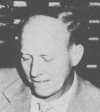 |
|
grew up in a household that was imbued with intellect. He studied Greek and Latin, and had an abundant facility with words. His interest in botany began in college at Washington University in St. Louis where he took frequent trips during vacation periods into the Ozark hills collecting plants and received an MS degree. During this time he became very familiar with the flora of Missouri and neighboring states. He spent a year studying at Harvard under Benjamin Lincoln Robinson and was awarded an MA in 1928. In 1929 he received a PhD from Washington University. Next he under- |
took graduate studies at the Missouri Botanical Garden. In 1930 he spent the summer abroad visiting various herbaria and attending the Fifth International Botanical Congress in England. During the next few years he produced several monographs on Tradescantia, the Apocynaceae, and Asclepias. From 1931 to 1935 he was an arborist at the Arnold Arboretum of Harvard University, then returned to the Missouri Botanical Garden where personnel at the garden under Woodson’s leadership began a long series of expeditions to Panama ultimately resulting in “Contributions toward a Flora of Panama.” On this project he worked until the end of his life. Despite his dislike for attending the meetings of professional societies, he was elected president of the American Society of Plant Taxonomists. (Photo credit: Brittonia Vol. 17, No. 1, Jan. 30, 1965)
-
Woodvil'lea: named for William Woodville (1752-1805), an English physician and botanist. The following is quoted from Wikipedia: “William Woodville was born at Cockermouth in Cumberland in 1752 into a wealthy Quaker family. He was apprenticed to the apothecary William Birtwhistle before going to study medicine at Edinburgh University, where he became the favourite pupil of William Cullen, and graduated MD on 12 September 1775. After spending some time on the continent he began to practice at Papcastle in his native county, but shortly afterwards moved to Denbigh. In 1778 he accidentally shot a man in his garden through his window and this led to him being disowned by the Quakers. In 1782 he came to London, became physician to the Middlesex dispensary, and was admitted a licentiate of the College of Physicians on 9 August 1784. On 17 March 1791 he was elected physician to the smallpox and inoculation hospitals at St. Pancras, in succession to Edward Archer, and published the first volume of a projected two-part history of inoculation (variolation) in 1796. However, he became particularly interested in Edward Jenner's introduction of what was soon to be known as smallpox vaccine, which used material obtained from cases of cowpox. He was one of the first to try the new method, but his results differed substantially from Jenner's, and there was disagreement about the effects of the new procedure. It was suspected at the time that Woodville's vaccine had become contaminated with material from his smallpox patients, a conclusion supported by detailed analysis of the evidence. Woodville, who was elected a fellow of the Linnean Society in 1791, had a strong taste for botany, and appropriated two acres of ground at King's Cross belonging to the hospital as a botanical garden, which he maintained at his own expense. His four volume book on medical botany published between 1790 and 1794 with 300 illustrations of medicinal plants by James Sowerby was an important reference work for physicians in the nineteenth century with a second edition in 1810 followed by a revision in 1832 by William Jackson Hooker and George Spratt. He wrote an important study of medical botany. Woodville, who was a member of the Society of Friends, had his residence in Ely Place, Holborn, but died at the smallpox hospital on 26 March 1805, and was buried in the Friends' burial-ground, Bunhill Fields, on 4 April. His portrait, by Lemuel Abbott, was presented to the smallpox hospital.” The genus Woodvillea was published by Augustin Pyramus de Candolle in 1836.
-
Woodwar'dia: named for Thomas Jenkinson Woodward (1745-1820), a British phycologist and botanist. He was born at Huntingdon in the Cambridgeshire district of England and was educated at Eton and Clare Hall, Cambridge, where he graduated with an LLB in 1769. Woodward was appointed a magistrate and deputy-lieutenant for the county of Suffolk. When he moved to Walcot Hall, Diss, Norfolk, he took on the same posts for that county. On the establishment of the volunteer system he became Lieutenant-colonel of the Diss volunteers. He was elected a fellow of the Linnean Society of London in 1789. Sir James Edward Smith described him as “one of the best English botanists, whose skill and accuracy are only equalled by his liberality and zeal in the service of the science," and he named the fern genus Woodwardia in his honor in 1793. Woodward contributed greatly to James Sowerby’s English botany, to William Withering’s Systematic Arrangement of British Plants, and to Philip Miller’s Gardeners’ Dictionary. He died at Diss on 28 January 1820, and was buried there.
-
wooton'ii: named for Elmer Otis Wooton (1865-1945), a professor of
chemistry and botany at New Mexico State
 |
|
College (1890-1911) where he was appointed as plant taxonomist, assistant curator at
the National Herbarium in 1910. He was employed by the US Department
of Agriculture from 1911 to 1935, and collected plants on Santa Rosa Island in 1941. Although taxonomy was one of his major interests, he was also very concerned with rangeland conditions and carrying capacities which he studied during botanical excursions throughout the New Mexico territory at the turn of the century. Among the books he wrote were Flora of New Mexico, Cacti of New Mexico, Saltbushes and their Allies in |
the United States, Certain Desert Plants as Emergency Stock Feed, Factors Affecting Range Management in New Mexico, The Public Domain of Nevada and Factors Affecting Its Use, and others.
-
wormskiold'ii: named for Morten Wormskjold (1783-1845), a Danish botanist and explorer who led a naval expedition
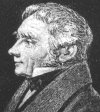 |
|
to Greenland in 1813 and made the first major collection of Greenland flora there, and who subsequently sailed with Adelbert von Chamisso and Johann Friedrich von Eschscholtz on Captain Otto Kotzebue's exploring voyage on the Rurik, but left the expedition at Kamchatka before it reached North America after he fell out with the Captain. He was born in Copenhagen to a family of civil servants. He graduated with a degree in law in 1805. He then chose to study botany under professor Jens Wilken Hornemann at the University of Copenhagen. In 1807 he accompanied |
Hornemann on a plant collecting expedition to Norway to gather data for the major work Flora Danica that was being compiled by Hornemann and others, but had to leave Norway because of the Napoleonic Wars. In 1812-1813 he made a botanical collecting trip to Greenland during which he also collected molluscs. He found 157 species of vascular plants which more than doubled the then known number. He died at Gavnø Castle and was buried at the nearby Vejlø Church . The specific name is often spelled wormskjoldii.
-
wormskjold'ii: see previous entry.
-
wort: an old English word for plant.
-
wrangelia'na/wrangelia'nus/wrangel'lii: named for Ferdinand Friedrich Georg Ludwig von Wrangell (in Russian
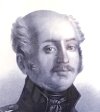 |
|
Ferdinand Petrovich Vrangel) (1796-1870). The following is from the website AllRefer.com: "Russian naval officer, arctic explorer, and government administrator. He commanded a Russian naval expedition that explored the Arctic. He led another Russian expedition around the world and was the first governor of the Russian colonies in Alaska, director of the Russian-American company, and minister of the navy. He was highly critical of the sale of Alaska to the United States in 1867. Several islands are named for him. His diaries of his arctic expedition have been translated |
into German and English." He was born in Pskov into the Baltic German Wrangel family and both of his parents died when he was ten. He graduated from the Naval Cadets College in Saint Petersburg in 1815. In 1820 he was assigned to command the Kolymskaya expedition to explore the Russian polar coastline, sailing up the Kolyma River into Yakut territory, traveling 46 days on the ice and reaching 72 degrees north. He established that the Kolyma River drained into the East Siberian Sea. His expedition made a valuable research in glaciology, geomagnetics, and climatology and also collected data about natural resources and native populations of that remote area. He returned in 1824. From 1825 to 1827 he commanded the Krotky on a round-the-world expedition about which there surprisngly appears to be little information. That voyage spent 8 days at Nuku Hiva, leaving when it was ambushed by local people. It also called at Hawai'i. In 1829 he was appointed as the governor of Russian colonies in Alaska, a position he held until 1835. Wikipedia says: “He traveled to his post early in 1829, by way of Siberia and Kamchatka. After thoroughly reforming the administration, he introduced the cultivation of the potato, opened and regulated the working of several mines, and urged upon the home government the organization of a fur company. He promoted investment, and sent out missionaries. He began a survey of the country, opened roads, built bridges and government buildings. He made geographical and ethnographical observations, which he embodied in a memoir to the navy department. Recalled in 1834, he returned by way of the Isthmus of Panama and the United States, where he visited several cities.” He was promoted to Admiral in 1837 and took over operation of the ship-timber department of the Navy, resigned in 1849 and assumed the presidency of the newly reorganized Russian-American Company of which he had been on the board of directors since 1840. He re-entered active service in 1854 and became chief director of the hydrographical department of the Navy and then Minister of the Navy 1855-1857, finally retiring for good in 1864. He was a member of the Saint Petersburg Academy of Sciences and a founder of the Russian Geographic Society. He wrote and published Wrangell's Expedition to the Polar Sea which was published in German in 1827 and translated into English in 1840, and other reports on his explorations. He died in Tartu, Livonia, which is an area currently divided between Latvia and Estonia.
-
wright'ii: named for Charles Wright (1811-1885), an American botanical collector. He was born in Wethersfield,
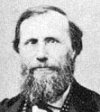 |
|
Conn., and having completed study at the Wethersfield Grammar School in 1831, he studied the classics and mathematics at Yale. His career began as a tutor for a family in Natchez, Mississippi, then he moved to Texas to work as a teacher and a surveyor for the Pacific Railroad Company, but he soon began collecting plants and sending specimens to Professor Asa Gray at Harvard, eventually becoming one of his most trusted collectors and carrying on a 40-year correspondence with him. Gray procured passage for him on an Army supply mission in 1849 across western Texas, but |
he ended up walking almost 700 miles from San Antonio to El Paso, all the time keeping his eyes glued to the ground the better to see small desert flowering plants. In 1851, again with Gray’s help, he became part of the Mexican Boundary Survey, and helped collect many of the 2,600 species that were sent back to Professor John Torrey for description and identification. His name was honored by George Engelmann who gave it to a cactus, Opuntia wrightii. Asa Gray based the first botanical work published by the Smithsonian on Wright's collection, Plantae Wrightianae (1852–53). Altogether he spent eight years botanizing in Texas and another eleven in Cuba. Wikipedia adds: “Between 1853 and 1856, he took part in the Rodgers-Ringgold North Pacific Exploring and Surveying Expedition, collecting plants in Madeira, Cape Verde, Cape Town, Sydney, Hong Kong, the Bonin Islands, Japan (at Hakodate, Tanegashima,and the Ryukyu Islands including Okinawa) and the western side of the Bering Strait. He collected over 500 specimens while the ships were delayed at Simon's Bay, near Cape Town. Wright left the expedition at San Francisco in February, 1856 and went south to Nicaragua. His collection of plants from Hong Kong was used by George Bentham for his Flora Hongkongensis (1861). Between 1856 and 1867, he led a [number of] scientific expeditions to Cuba. In 1859 he joined Juan Gundlach in the area around Monteverde, and in the winter of 1861-1862 they explored together around Cárdenas. He was also still in communication with Asa Gray and via him, Charles Darwin, discussing orchids. This was possible because at the start of the American Civil War, he was in Cuba and Gray kept him there until 1864 to keep Wright safe and his ongoing botanical work intact. In 1871, he went with the US Commission to Santo Domingo. From 1875-1876, he was the librarian of the Bussey Institution at Harvard University.” In 1868 he served as acting director of the Gray Herbarium. He is commemorated in the genus Carlowrightia of the Acanthaceae, and in the names of many species. Wright, who never married, spent his last days in Wethersfield with his brother and sisters, all unmarried, and died on August 11, 1885, of a heart ailment dating back to his years in Cuba. (All taxa except for the three named for William Greenwood Wright)
-
wright'ii: named for William Greenwood Wright (1831-1912), one of the first lepidopterists in California, author of Butterflies of British Columbia, The Butterflies of the West Coast of the United States (1905), Colored Plates of the Butterflies of the West Coast (1907), and Butterfly Hunting in the Desert. He was born in Nelson, New Hampshire, and died in San Bernardino, California. In addition to being known primarily as a collector of moths and butterflies, according to the Harvard University Herbaria database of botanical specimens he also collected specimens of some 93 taxa of plants. He was a soldier in the Civil War and some time after that conflict ended he went to California, where he lived for a while in Los Angeles and then moved to San Bernardino around 1873 where he operated a planing mill and sash and door plant. He was a great friend of two noted botanical collectors, C.C. Parry and Edward Palmer, and he was also intimately acquainted with Samuel B. Parish. He traveled all over the West Coast from Alaska to Mexico collecting natural history specimens, mostly but not limited to butterflies. He was found by a visitor dead in his home and had been deceased for at least 24 hours when found. After his death his massive collection of butterflies was sent to the California Academy of Sciences in San Francisco. ( Chrysopsis wrightii, Hemizonia wrightii, Collinsia torreyi wrightii)
-
wrigleya'na: named for William Mills Wrigley, Jr. (1861-1932), an American businessman, chewing gum industrialist,
 |
|
and a developer of Santa Catalina Island. He was born in Philadelphia to Quaker parents of English descent. In 1870 his father founded and served as president of the Wrigley Manufacturing Company, the main product of which was Wrigley's Scouring Soap. The young Wrigley went out into the streets of Philadelphia and sold soap from a basket, then ran away with a friend to New York where he did odd jobs and sold newspapers. This only lasted a few weeks and he returned to Philadelphia where he found himself constantly in trouble and either left school or was expelled. He |
went to work in his father’s factory stirring vats of liquid soap then moved into a regional sales job, either traveling by train throughout the Eastern states or selling soap from a bright red wagon with four horses and bells. Wrigley again tried to establish himself away from his father's business at the age of 18, going west but losing his railroad ticket in Kansas City. Eventually, he returned to Philadelphia and rejoined his father’s factory, continuing in the business for more than a decade before leaving again. In 1891 he moved to Chicago to try business for himself. He started selling Wrigley’s Scouring Soap and offering containers of baking powder for each sale. Finding the baking powder more popular, he began selling that along with packages of chewing gum for each sale. Again he found the premium was more popular than the sale item and he started concentrating on the product that eventually made his fortune, Wrigley’s gum. The chewing gum business was highly competitive in the late 1880s with at least a dozen companies making their own brands, but by 1910 Wrigley’s Spearmint was the top-selling gum in the US. He eventually became the largest gum manufacturer in the world, with companies and manufacturers in Great Britain, Canada, Australia and New Zealand. Wrigley is also well known for his relationship with Santa Catalina Island. He bought a controlling interest in the island in 1919 and improved the island with public utilities, new steamships, a hotel, the casino building, and extensive plantings of trees, shrubs, and flowers. Wikipedia says “He also sought to create an enterprise that would help employ local residents. By making use of clay and minerals found on the island at a beach near Avalon, in 1927 William Wrigley Jr. created the Pebbly Beach quarry and tile plant. Along with creating jobs for Avalon residents, the plant also supplied material for Wrigley's numerous building projects on the island. After the building of Avalon's casino in 1929, the Catalina Clay Products Tile and Pottery Plant began producing glazed tiles, dinnerware and other household items such as bookends.” He bought a minority stake in the Chicago Cubs baseball team and by 1921 he was the largest shareholder and principal owner. Wrigley Field was named for him. In 1925 he became the sole owner. His winter mansion, built on Millionaire’s Row (Orange Grove Avenue) in Pasadena, California, is now the headquarters of the Rose Float Association. In 1930, Wrigley bought the Arizona Biltmore, a winter resort outside Phoenix, inspired by the work of Frank Lloyd Wright. He died in Arizona and was interred first on Catalina Island and later moved to Forest Lawn Cemetary in Glendale. Encyclopedia.com says: “When Wrigley died on January 26, 1932, The New York Times reported it was ‘of acute indigestion, complicated by apoplexy and heart disease.’ He passed away in a home he built near the Arizona resort. His simple philosophy was summed up, ‘To be always pleasant, always patient, always on time, and never to argue.’ He set the tone for the company by constantly telling his son, ‘We are a five-cent business, and nobody in this company can ever afford to forget it.’ ”
-
Wulfen'ia: named for Franz Xaver Freiherr von Wulfen (1728-1805), an Austrian botanist, zoologist, mineralogist,
 |
|
alpinist, and Jesuit priest. He was born in Belgrade and his father was a high-ranking Lieutenant in the Austrian Army of Swedish descent. He was educated at Kaschau Gymnasium in present-day Košice, Slovakia. When he was 17, he joined the Jesuit order and attended a Jesuit school in Vienna. Wikipedia provides the following information: “Following his graduation, he became a school instructor (chiefly of mathematics and physics) in Vienna, Graz, Neusohl, Gorz, Laibach (Ljubljana), and from 1764 Klagenfurt. From his twenty-second year he devoted himself to botany. |
The upland and valley flora of the Eastern Alps was his chief study. To find specimens, Wulfen frequently hiked up the Großglockner and was a pioneer in exploring the Austrian Alps. In 1781, he published his studies in the well-illustrated Plantae rariorum Carinthicae (Rare Plants of Carinthia). With particular success, he conducted research of lichens that he still regarded as a division of algae. He made numerous trips to the south (on many occasions to the Adriatic Sea) and to the north as far as Holland. Wulfen was also a researcher of the fauna of the Inner Austria and the Adriatic Sea. He concerned himself primarily with insects, fish, and birds. In 1796, Wulfen was elected a foreign member of the Royal Swedish Academy of Sciences.” A website called Catholic Answers says this: “His unusual talents, his great exactness in observation and description, and his researches, carried on tirelessly for over fifty years, constitute him one of the leading botanists of the post-Linnaean epoch (the last third of the eighteenth century). He was a member of the academies or scientific societies of Berlin, Erlangen, Gottingen, Jena, Klagenfurt, Ratisbon, and Stockholm, and enjoyed a high repute with botanists of all lands, with whom he carried on an extensive correspondence in Latin, German, French, and other languages. He discovered many new species, of which he gave masterly descriptions in Latin and which he illustrated with excellent plates. The mineral Wulfenite (yellow lead ore) recalls his mineralogical studies and rich mineral collection. He published mineralogical, zoological, and botanical treatises in various periodicals and collections. Much of his literary work was printed only after his death, for example, his chief work Flora norica phanerogama (Vienna, 1858).” After the suppression of the Society of Jesus in the 1760s, he remained in Klagenfurt until his death at the age of 76 years. The genus Wulfenia was published by Nicolaus Joseph von Jacquin in 1781.
-
Wyeth'ia/wyeth'ii: named for Nathaniel Jarvis Wyeth
(1802-1856), an American inventor and businessman who
 |
|
greatly contributed to the ice industry in Boston and elsewhere by inventing ice-harvesting tools and above-ground ice houses, and thus helped to facilitate New England's trade in ice with the Caribbean, Europe, and India. He was also a plant collector and explorer who discovered
plants and sent samples to his friend Harvard botanist Thomas
Nuttall who accompanied him on his second expedition. He is considered
one of the great pioneers of Oregon, having blazed pathways that would
become known as the Oregon Trail. His expeditions to the Northwest were not commercially |
successful because he was competing with the Hudson Bay Company. He is best known in botany
for the plant called mule's ears which was named Wyethia in his honor by Nuttall in 1834. He was the great-grandson of shoemaker Ebenezer Wyeth (1698-1754), who was the great-great-great-great-grandfather of the famous painter Andrew Wyeth (1917-2009. Nathaniel's father was Jacob Wyeth (1764-1847) and his grandfather was Ebenezer Wyeth, II (1727-1799). I can't find anything online about his early life other than that he was born in Cambridge, Massachusetts, in his father's Fresh Pond Hotel. He seems to have had little if any education, and during the hotel's winter off season, he worked to stock the hotel’s ice house with ice cut from Fresh Pond. The ingenious horsedrawn ice-cutter that he invented allowed uniform blocks of ice to be cut and harvested, and he went to work for Frederick Tudor, a regional ice supplier. Seeking a broader world, he became interested in the opportunities that beckoned in the Oregon Country, and he enrolled in Hall Kelley’s “American Society for Encouraging the Settlement of Oregon,” founded in 1829. Hall's plans moved too slowly and so Wyeth organized a joint-stock company, to trade for furs on the Columbia River, leaviing Boston with twenty men bound for St. Louis. His lack of wilderness knowledge led him to join Robert Campbell and William Sublette on a pack train destined to resupply the Rocky Mountain Fur Company. Then began years of plans that never worked out as he traveled extensively across the northwest, trying one thing after another, including dealing in salmon from the Columbia River, and eventually returned to the ice trade in Boston, and applied for and recieved numerous patents for devices involved in the ice trade. Later through his letters and memoirs, he did much to familiarize people in the east with the potential of the Oregon Country, and thereby helped open the door to the emigrant waves that spread westward in the final years of the 1840s. He is often referred to as Captain Nathaniel Wyeth, but this appears to have been an honorary or self-chosen title. A website of the National Park Service says: "Although business ventures were his primary interest on the Columbia, Wyeth proved to be a good observer of landscape and natural details. He described the extensive prairies of the Puget Trough 'bound by a skirting of timber' that included Garry's oak, and studied the ducks and geese wintering on the river. Also residing at Fort Vancouver that winter was the Scottish naturalist David Douglas, with whom Wyeth 'had some dispute' over the classification of grouse found in the interior. The two men also shared an interest in plants; Wyeth was friends with the botanist Thomas Nuttall, whose Genera of North American Plants Douglas often referenced for plant identification. It is possible that Douglas helped collect samples of flora and fauna along the Columbia that Wyeth shipped east for Nuttall." It does not appear that Wyeth ever married. He died in Cambridge, Massachusetts. The genus Wyethia was published in 1834 by Thomas Nuttall. (Thanks to David Brown for providing information on Nathaniel Jarvis Wyeth's ancestral relationships).
- wynd'ii: named for Frederick Lyle Wynd (1904-1987), a botanist and ranger-naturalist at Crater Lake National Park
 |
|
from 1923 to 1930. His name was pronounced ‘wind’ as in ‘to wind a clock.’ He was the first person to do major botanical work at the park. He was born in Normal, Illinois, and raised at Fort Klamath, Oregon. JSTOR says this: “F. Lyle Wynd was appointed at the age of 18 as a ranger naturalist at Crater Lake National Park in Oregon, working with C. Hart Merriam. He produced the first published flora of the park, listing 433 species. All but three were collected by Wynd himself, between 1923 and 1933, and are now housed in the University of Oregon herbarium. In 1936, he led |
a botanical expedition, sponsored by the Universidad Nacionál de México, into the Sierra del Carmens, Coahuila, and the following year returned to collect at Cuatro Cienegas. He later earned his PhD in plant physiology and taught at the University of Illinois and the University of Michigan.” After coming to the Crater Lake region, he came to know William Gladstone Steel, who was the founder of the park. An article in the Bulletin of the Native Plant Society of Oregon by Rhoda Love fleshes out some of his biographical details. Wynd moved to Eugene at some point and graduated from Eugene High School, where it is likely that he either knew or at least met Lincoln Constance, four years his junior. To quote some parts of the article: “Both were students of Louis F. Henderson at the University of Oregon and it was Wynd who introduced Constance to Crater Lake National Park. Wynd took both his bachelor’s (class of 1928) and master’s degrees at the University of Oregon and in his thesis thanked Professor Henderson for assistance. He sold his collection of Crater Lake plants to the University of Oregon Herbarium to help finance his research. His work as a ranger at Crater Lake anticipated that of Lincoln Constance who worked there from 1930 to 1934. Constance must have stepped into the Crater Lake post at approximately the time Wynd left Oregon to attend graduate school in St. Louis. Wynd took his PhD at the Shaw School of Botany at Washington University in St. Louis in soil biochemistry. He then taught at various colleges in Ontario, Missouri and Illinois before taking a post at Michigan State College in East Lansing where he was chairman of the botany department in the 1940s. At that time, he was an advisor on soil science to the famous King Ranch in Texas. Upon retiring from teaching in the Midwest Wynd returned to Eugene as an academic administrative assistant in the UO biology department. He retired from that post at age 65 in 1969 and became a marine guide in Alaska for the Explorers’ Club.” Elizabeth Horn in an article entitled “The Botanists at Crater Lake National Park” has this to add: “F. Lyle Wynd (1904-1987) spent his youth at Fort Klamath, only ten miles from the Park’s boundary and became enthralled with Crater Lake. He was only 18 when he started working there as a ranger naturalist. Between 1923 and 1930 he collected extensively, and six years later he published the first Flora of Crater Lake National Park. His specimens became part of the University of Oregon Herbarium (now housed at Oregon State University).” He died in Eugene at age 82. (Photo credit: Bulletin of the Native Plant Society of Oregon)
- wyomingen'sis: of or from Wyoming.
|
